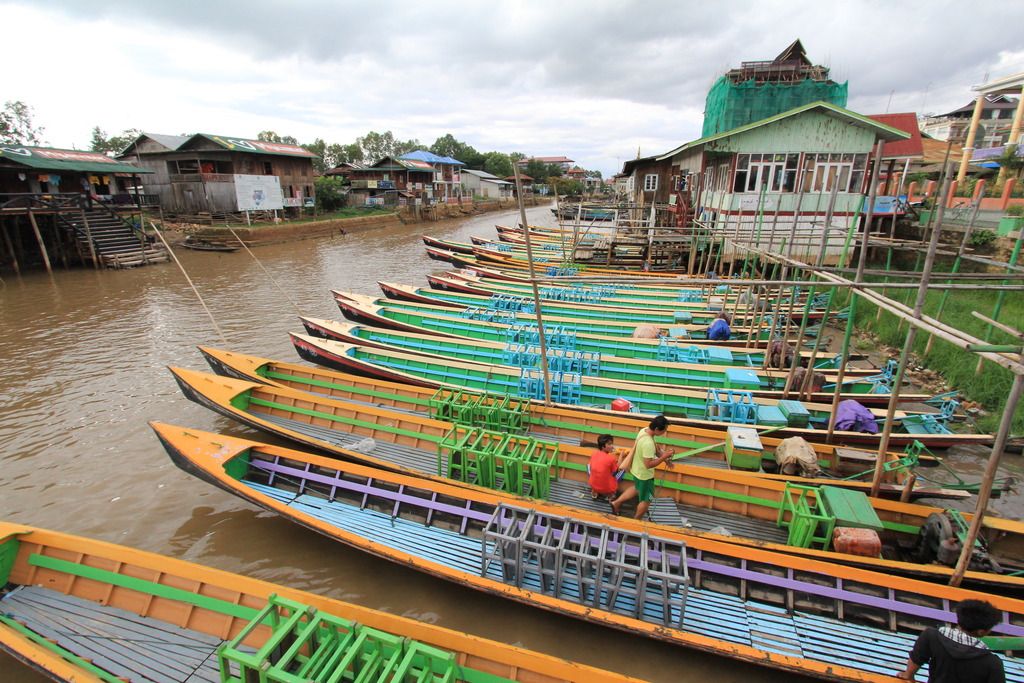Appologies for the delay in posting. It has been near impossible to upload multiple photos from any of the places that I have been, then once in Europe, I jsut lost motivation! Anyways,
The Le Meridian was a very nice hotel, far more so than the one in Chiang Mai. That is probably because it was more of a resort instead of more of a business hotel. Regardless, in the morning it was nice sitting on the deck, looking towards the river. Both my dad and I said that we could have spent another night there.
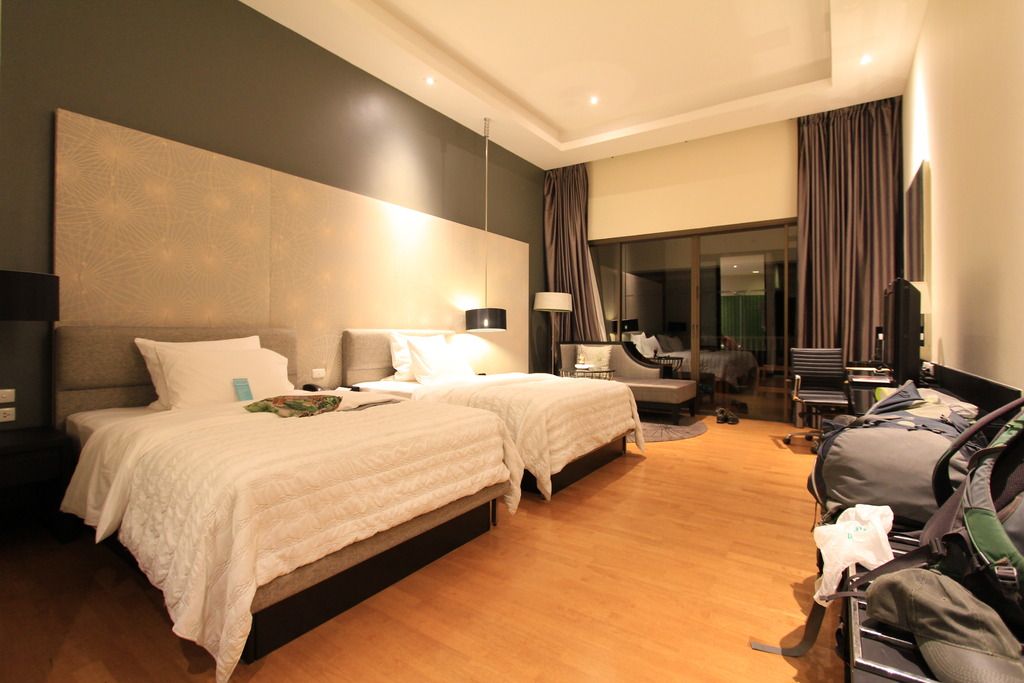
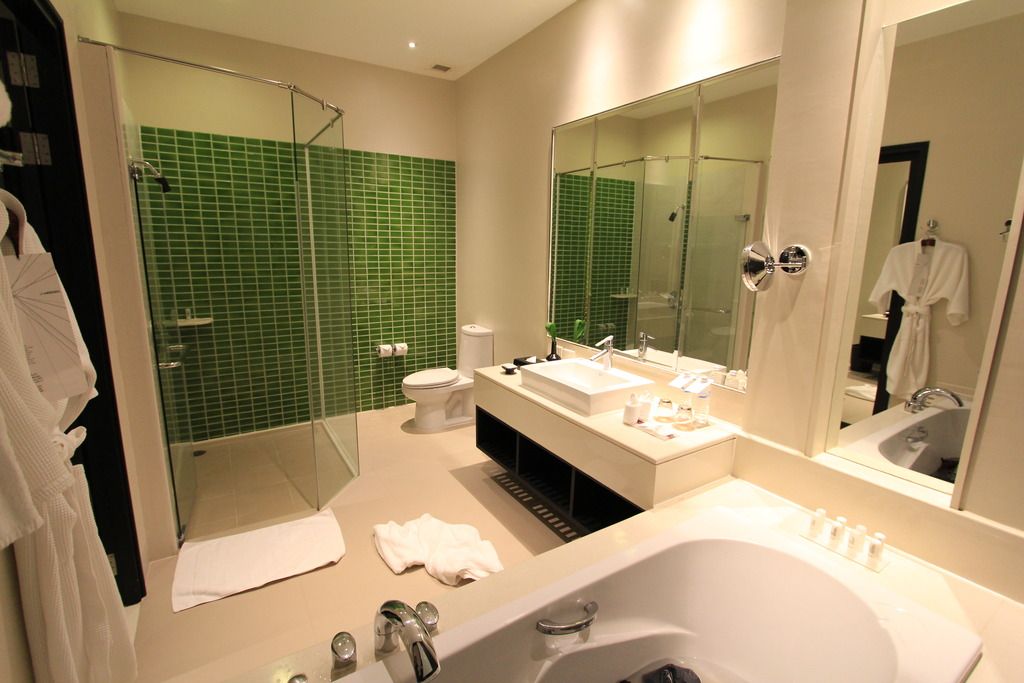
A nice touch was some free coffees outside in the morning. We then walked around the grounds a bit, checking out the river and the pool. Apparently you can take a boat down the river to the hotel, which would have been kind of cool, similar to the boat from Thaton, which you can apparently also have stop here.
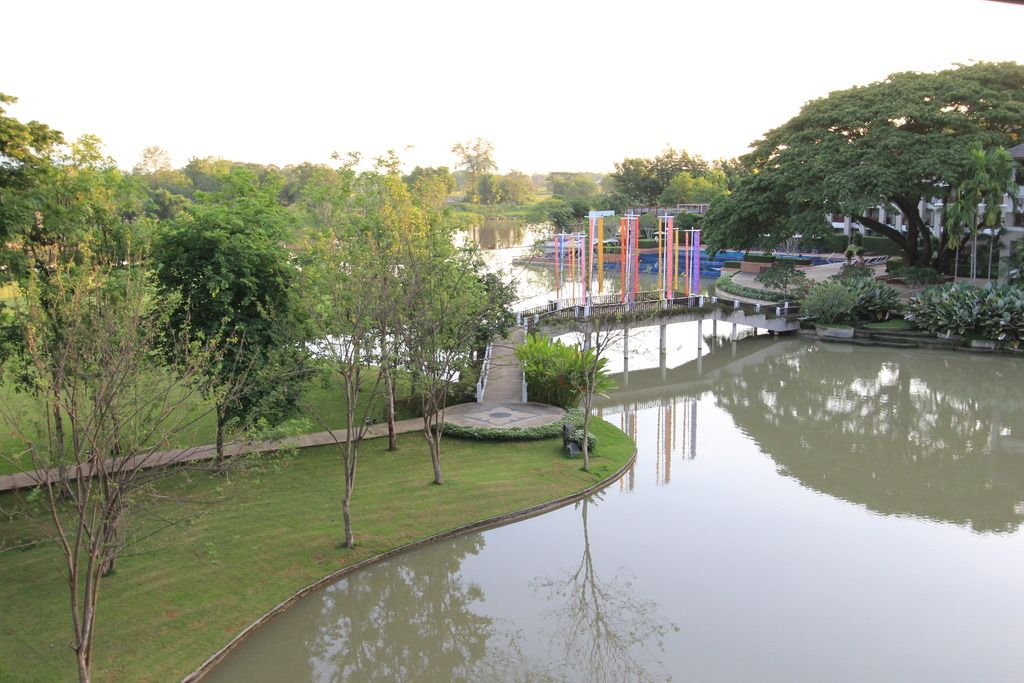 View from the deck.
View from the deck.
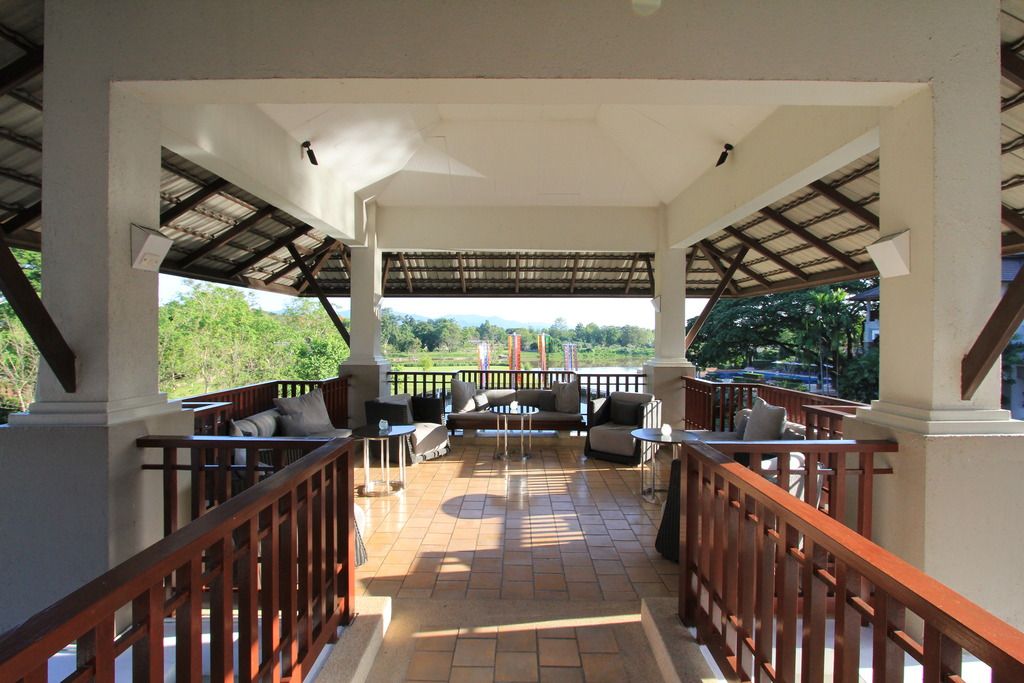 Coffee sitting area.
Coffee sitting area.
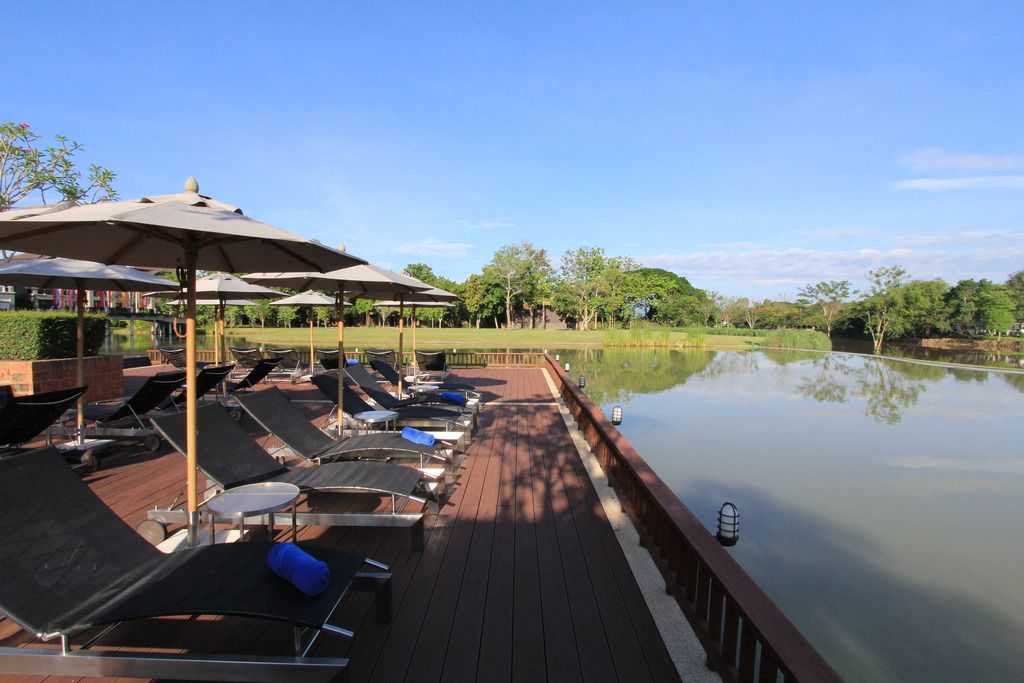 Pool.
Pool.
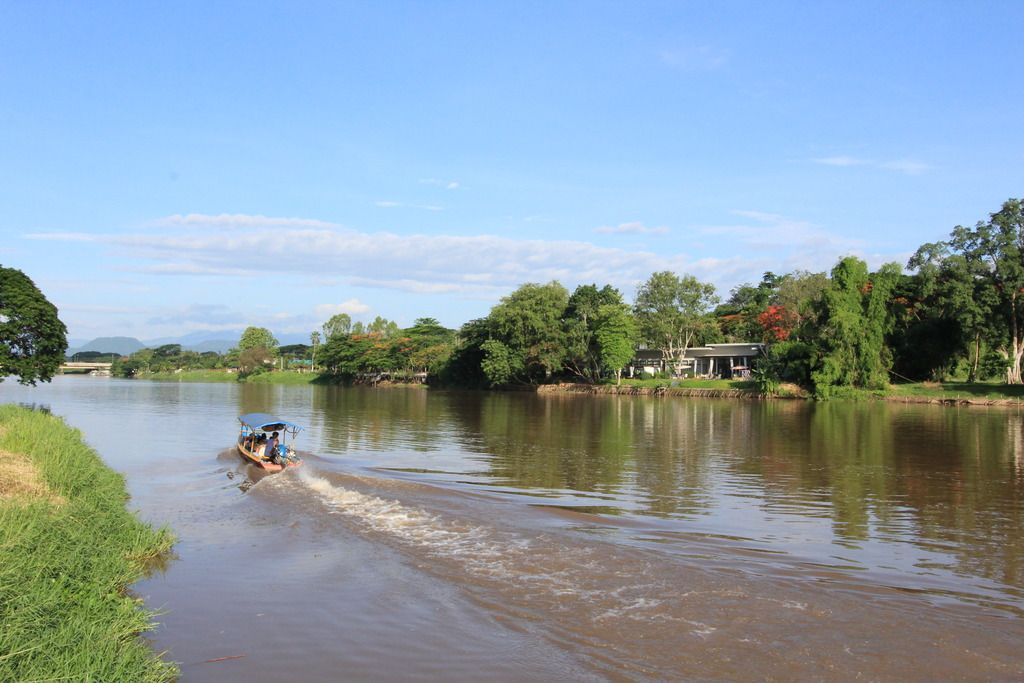 Boat departing the resort.
Boat departing the resort.
After walking around a bit, it was off to the border. We left the hotel at 7:50 via metered taxi to the bus station, which cost us 66 Baht, cheaper than the 100 Baht tuktuk that took us there the previous night. From the bus station it was a painless 10 minute wait for the next bus that went to Mai Sai, aboard one of the more classic buses I have ever taken.
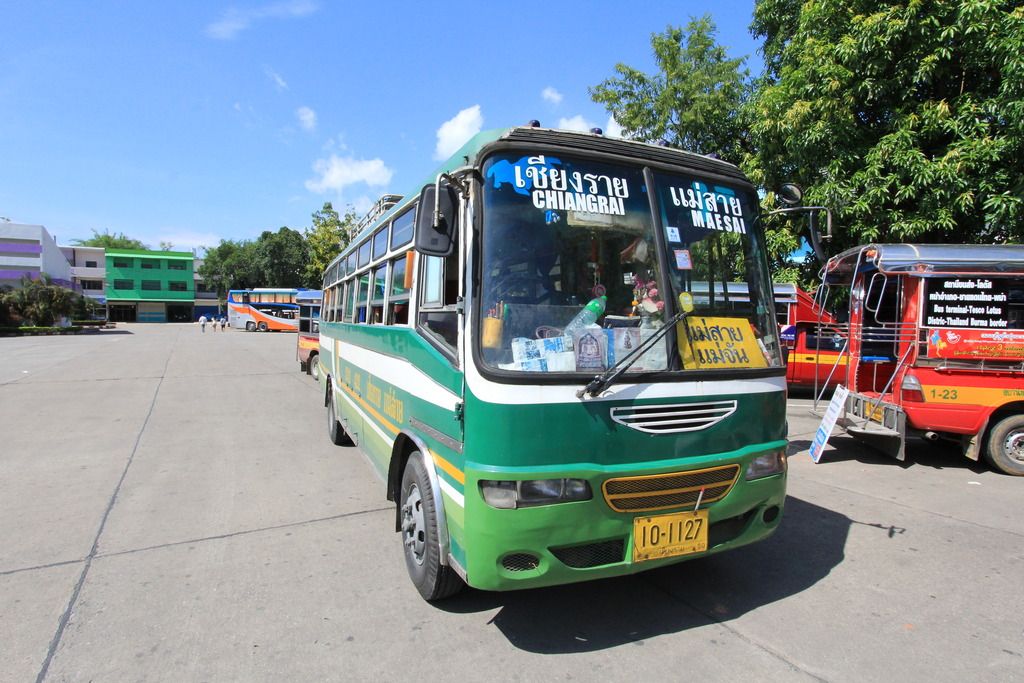
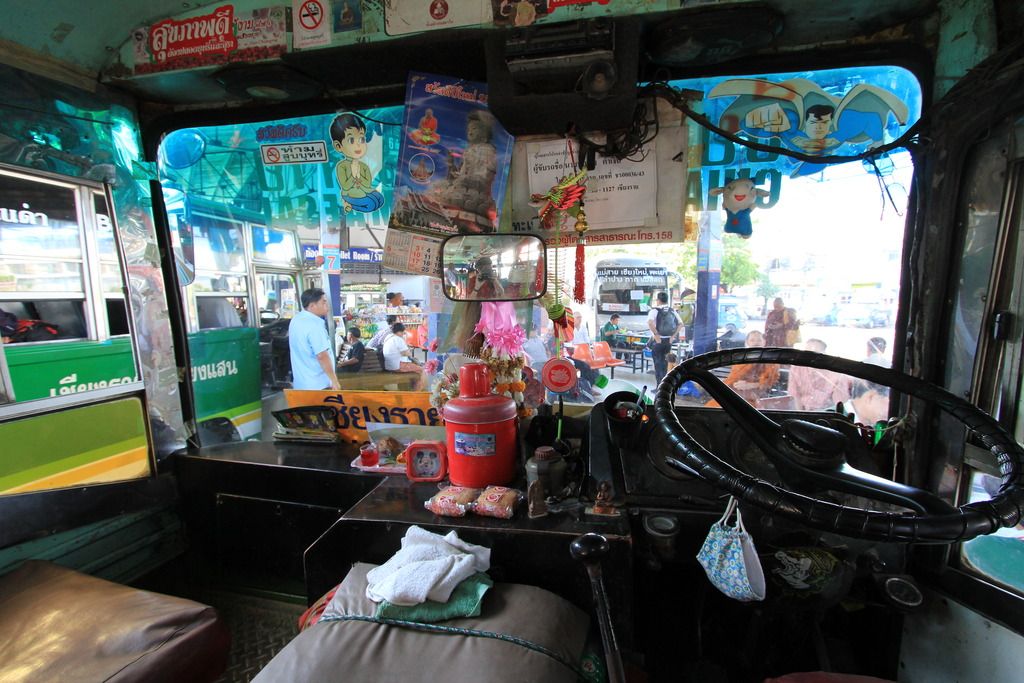
This bus had character, and so did the man driving it. Cruising down the road at about 38 MPH in a 50ís rig with sticker plastered all over the windshield and a small shrine on the dashboard was classic. Donít forget the stickers on the speedometer and rev counter, since those clearly did not work. A short 1.5 hours later and 39 Baht/ea poorer we were pulling into Mai Sai.
The bus driver helped us in the right direction, which was a 15 Baht Pickup into town (that seemed a tad high to me for the distance), which dropped us about 50 meters from the border. We grabbed our things and walked towards the end of Thailand. I lost my departure card, which the immigration officer found to not be funny, making me wait and probably thinking that he made me .... my pants a bit (that was anything but the case...itís more of a ďI am trying to leave, and you wonít let me, I see how it isĒ attitude). Eventually, he gave me a new one, and we were stamped out of Thailand.
We had to have Myanmar visas in our passports for this leg of the journey. If you make a land border crossing, you need to have your visa already. The process was painless. I sent it to DC before we left on a Friday, and got them a week later, using USPS Priority mail (USA, you have done better than Fedex and UPS, for half the price, props). The visa cost us $20 USD.
Stamping into Myanmar was easy: fill out an immigration card, get your photo taken, then let the police write down all of your information. After that it was walking into the bustling tuktuk mafia, where we found someone to take us to the bus station. These guys are sheisty, as they said one price at the beginning, but then multiplied that by 3 once we got there. For reference, there is an ATM at the KBZ bank, 50 meters from the border as well as a place to change USD (you cannot at any of the unofficial money changers at the border).
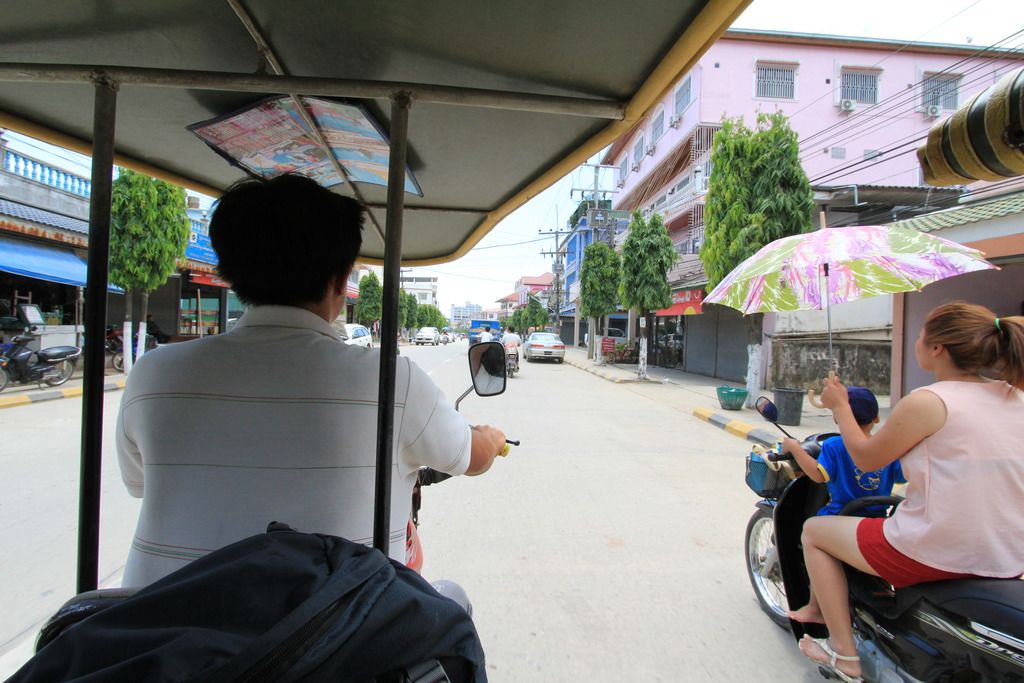 Tuk Tuk
Tuk Tuk
The bus was pretty easy. It departed at noon, cost 10,000 Kyat (pronounced chaat), and they took care of all the immigration stuff for you, which consisted of about 6 copies of our passport/visa. The drive was very scenic, and fairly remote. It took 5 hours to cross the 163 kms, so it is slow going on winding roads.
We did have a nice experience at our rest break town, where we bought some bananas. After buying the bananas we were sitting on the side of the road, looking around at some people, when the store owner came up to us and asked us to come over for some green tea. Before we knew it, we were sitting in his house, drinking tea and eating super sweet sugar cane candies. A Webster dictionary from Burmese to English sat on the shelf, open, where the man said is how he learned English. I also asked him where we were, and he printed it onto a piece of paper with excellent penmanship. We chatted a bit more before the bus horn sounded and we were to be on our way. It was cool to be invited into someone's home like that that easily. A great welcome into Myanmar.
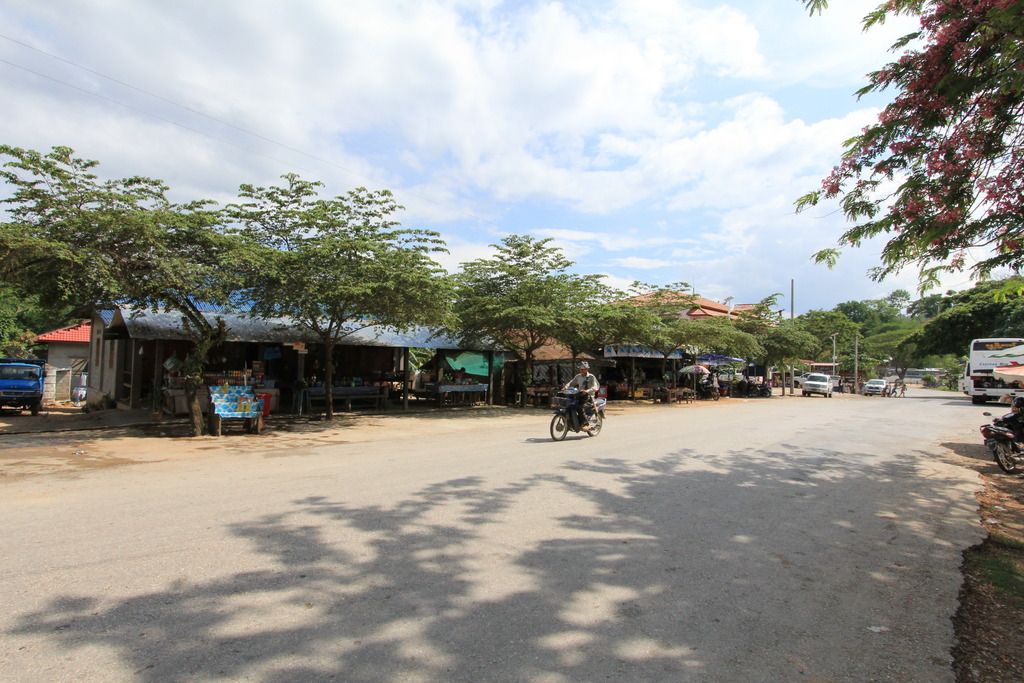 Rest stop.
Rest stop.
We arrived into Kengtung around 5, where Francis, our guide, took us to our hotel for the next 4 nights, the Naung Tong Hotel. The hotel was located right next to the market, which was great as it provided convenient access (I am a market person, so that is a big thing). Beyond that, the hotel wasnít anything special, nor anything atrocious. It got the job done, and I think most hotels are like that in Kengtung, let alone Myanmar in general.

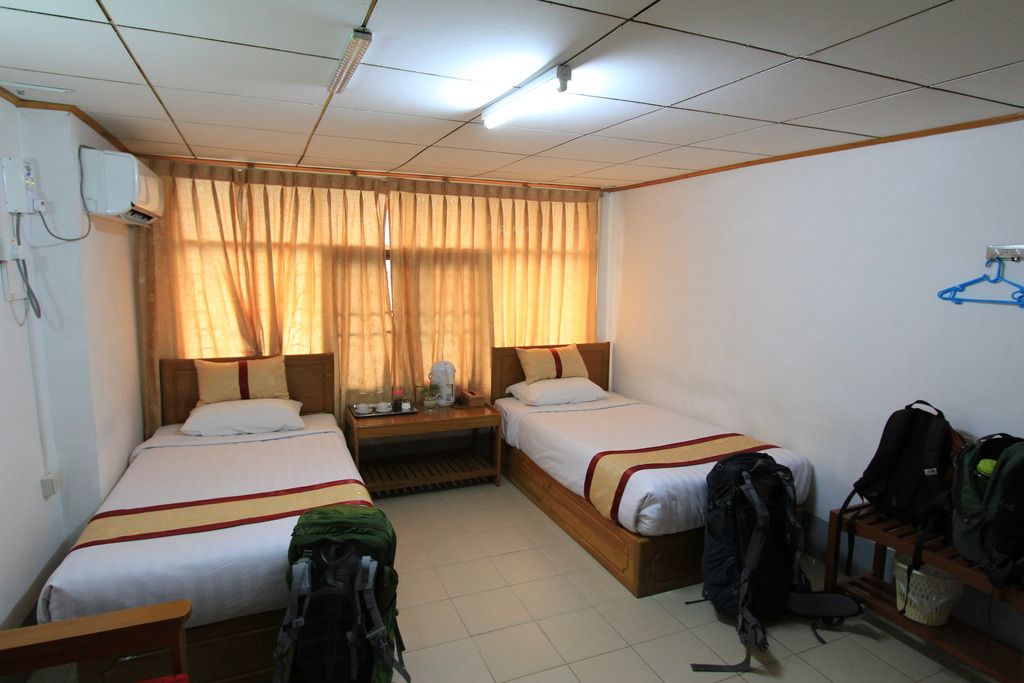
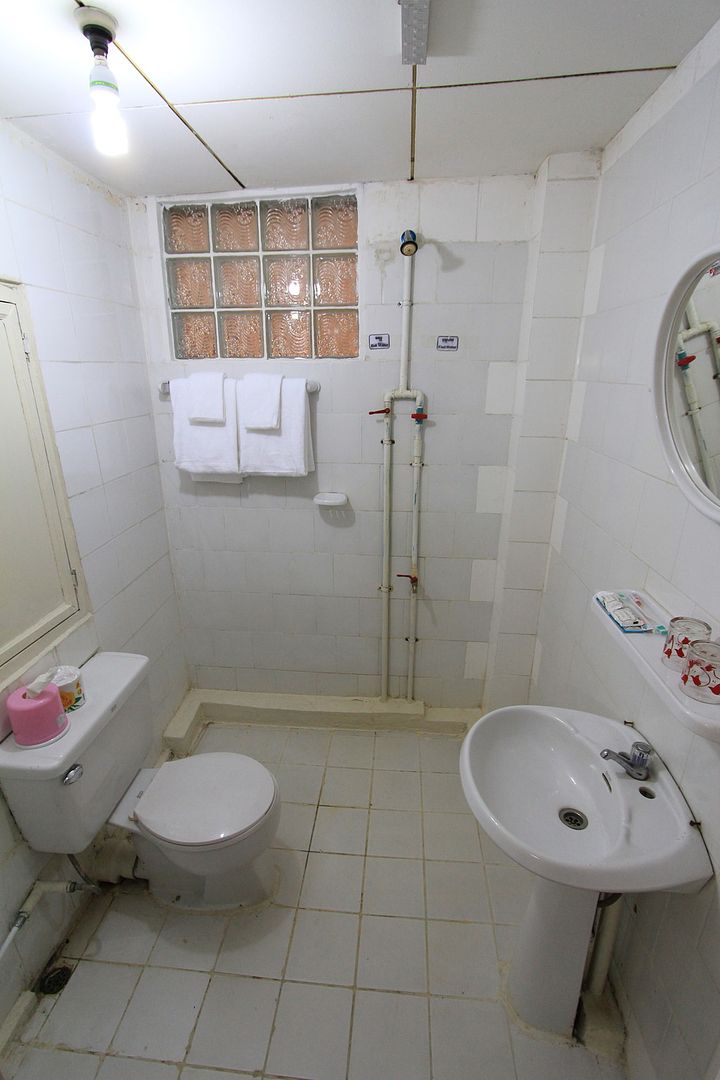
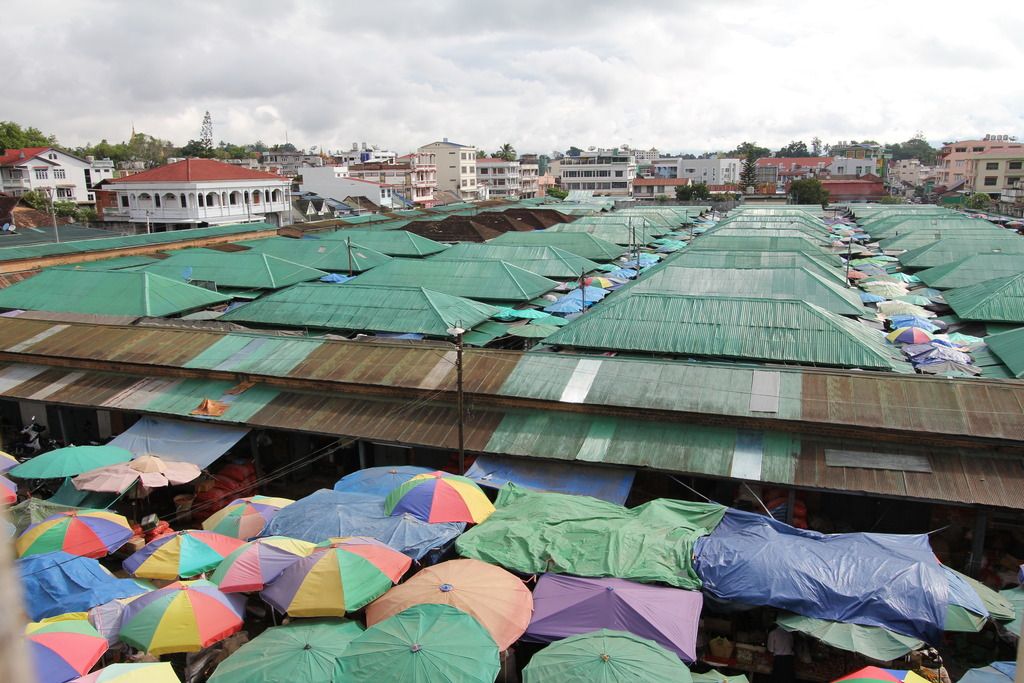 View over the market.
View over the market.
We met Francis again, and went to dinner at Pan Ka, which was a nice outdoor restaurant close to the airport. The food was good, but nothing out of this world. I donít think I have had out of this world food since being in the country, to be honest.
From there, it was back to our hotel, the Naung Tong Hotel.
For the hill tribes, I think pictures put things together more than words. It is hard to write about every specific of the people, and each tribe, so iíll just post a bunch of pictures.
In the morning, Francis took us on motorbikes to do some hill tribe trekking after breakfast and a visit to the market to get lunch. We drove about an hour on the motorbikes (we were not allowed to drive, which seems to be a reoccuring theme in Myanmar), through some very nice scenery, where we then left the motorbikes and hiked three hours to the Kong Pak Village, a La Hu Shi Tribe. The trek to the tribe was pretty easy, the only thing was the heat which was kicking us, but you get over it eventually.
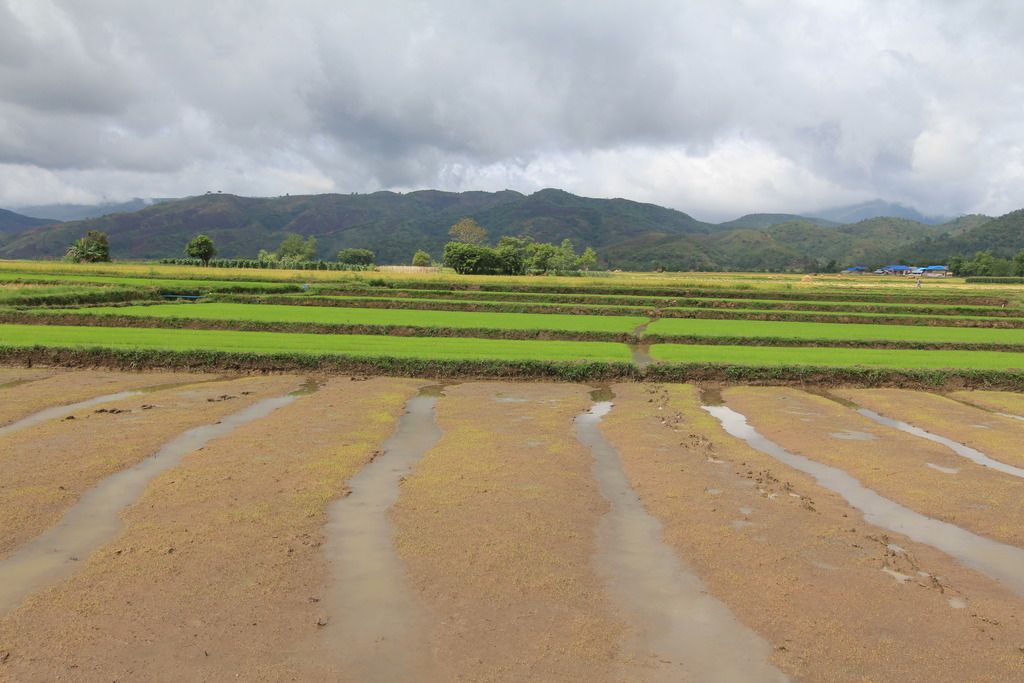 Rice fields enroute.
Rice fields enroute.
The La Hu Shi tribe was a bit underdeveloped. They were definitely set in their ways, where the other tribes we visited had televisions and lights in their huts. I guess you could call them more authentic. Regardless, the views were beautiful, but the interactions with the people felt slightly staged. I mean staged in the sense that everyone lined up for us, and Francis handed some guy a bag of cookies and everyone got one. During that time we were supposed to take pictures. A few other things made it feel staged, and slightly disconnected, but when I think about it, this is going to be more authentic than some places in Thailand, I think. With that, I think these people were not too keen to see tourists, or anyone really. They were in the stage between being on their own, and welcoming the tourism to sell things to them, but needed to get right over the love hate, is what it seemed like.
[
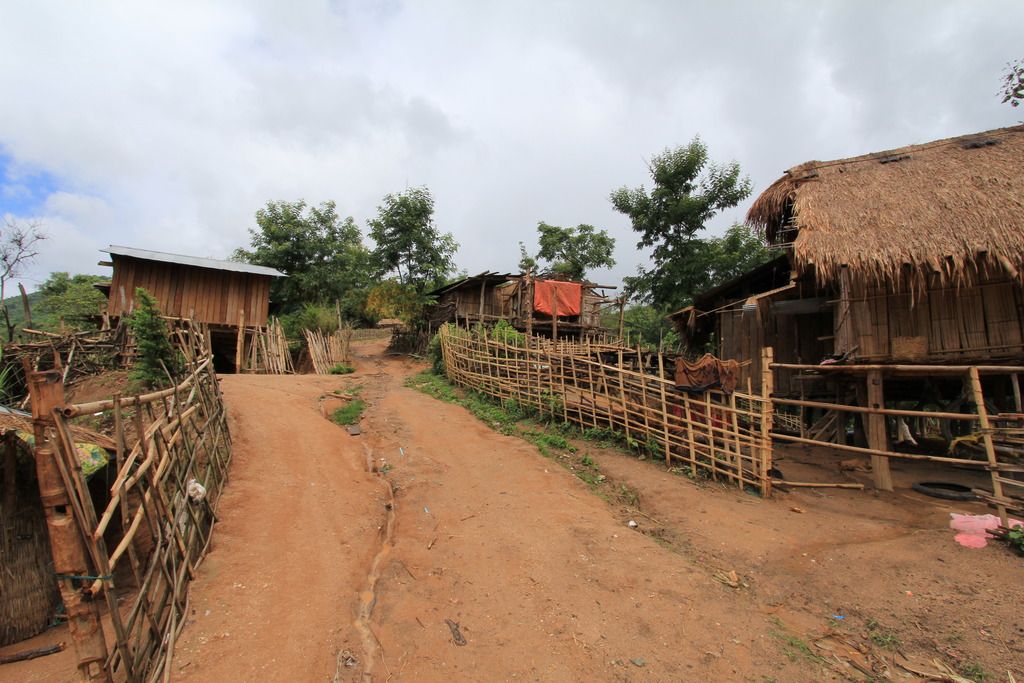 Beginning of the trek.
Beginning of the trek.
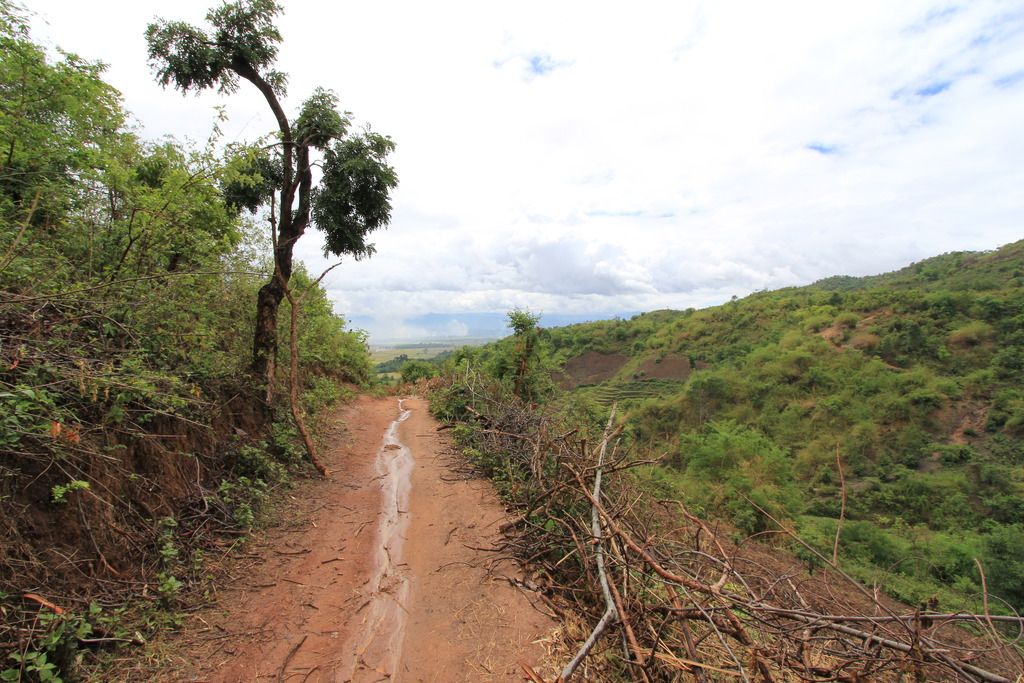


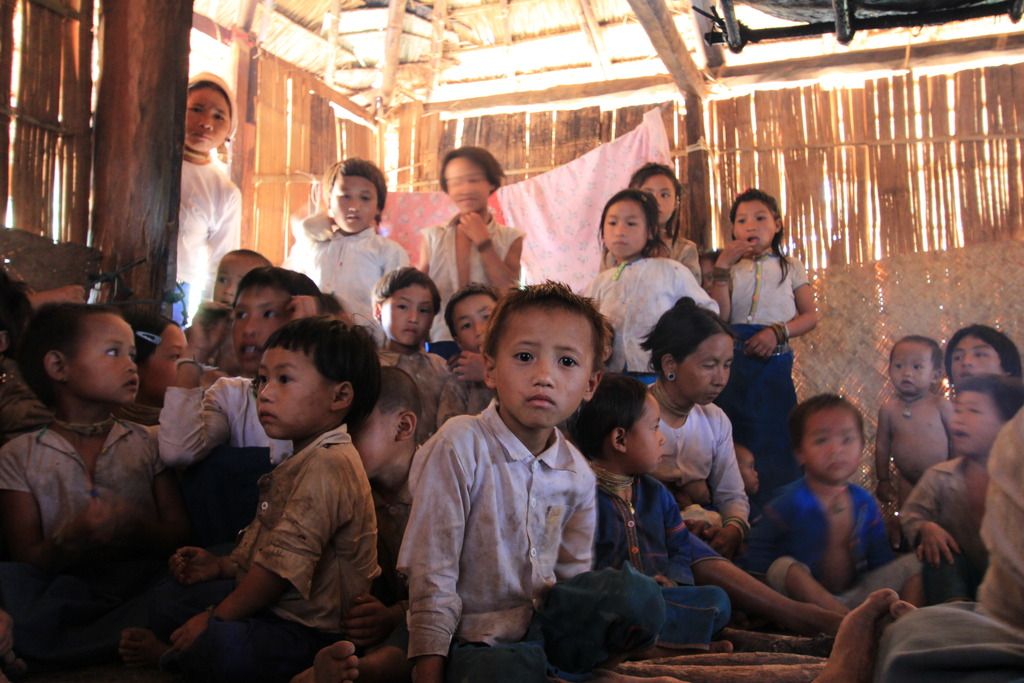 Kids inside the hut.
Kids inside the hut.
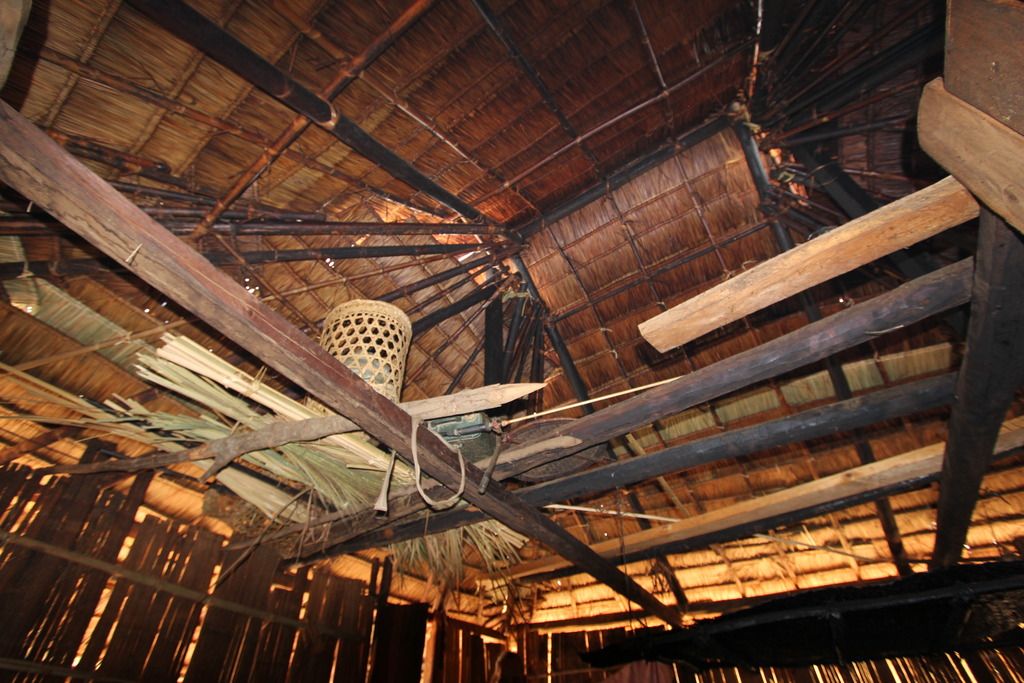
 Kids.
Kids.
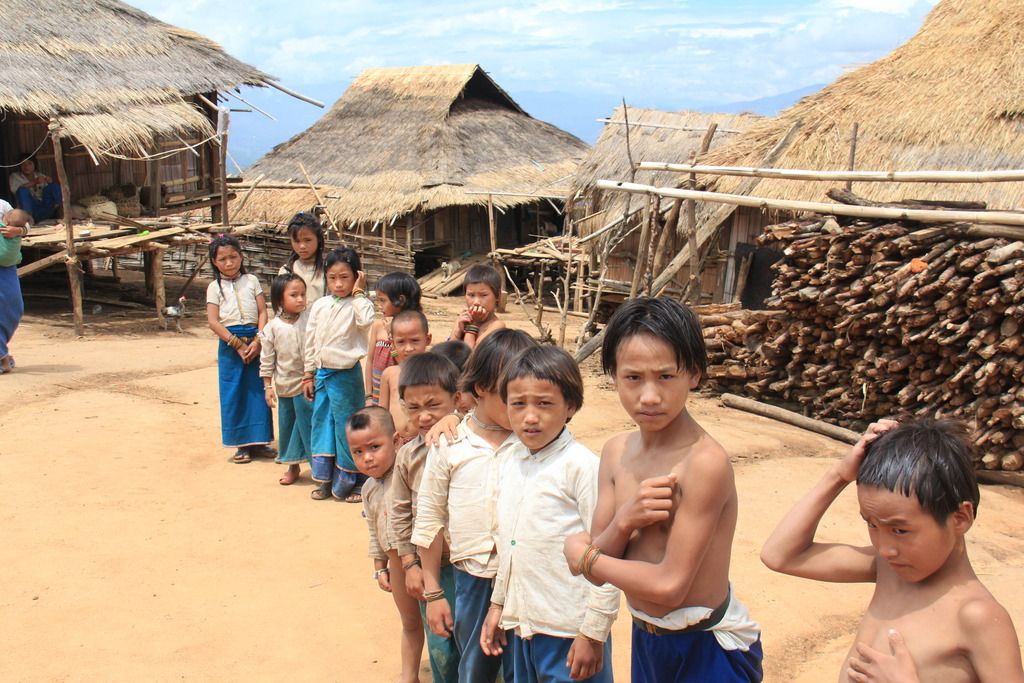
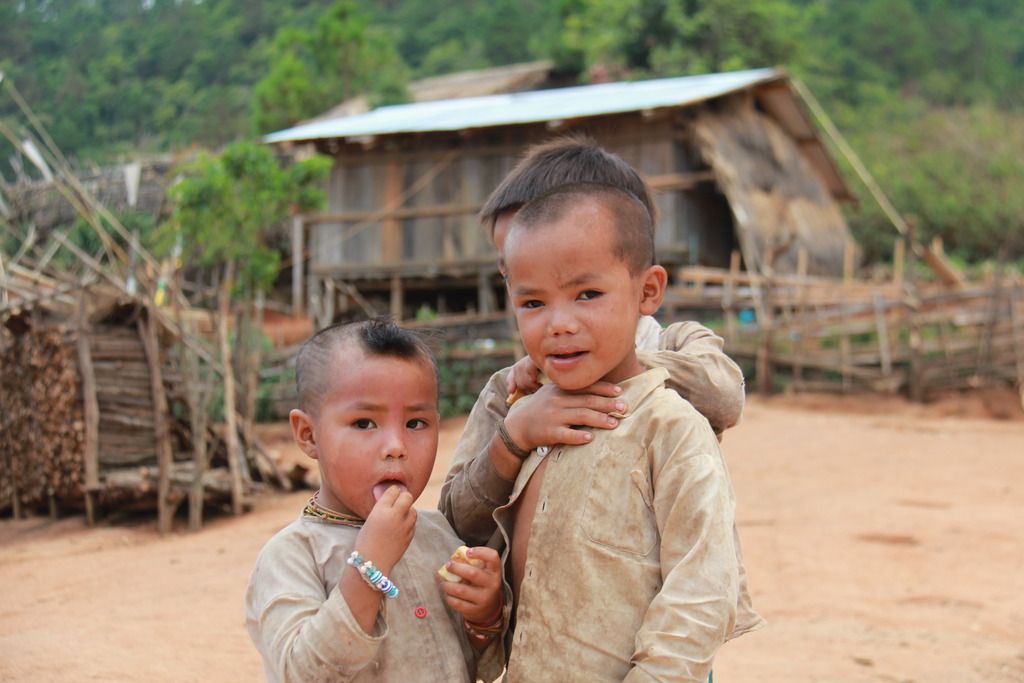
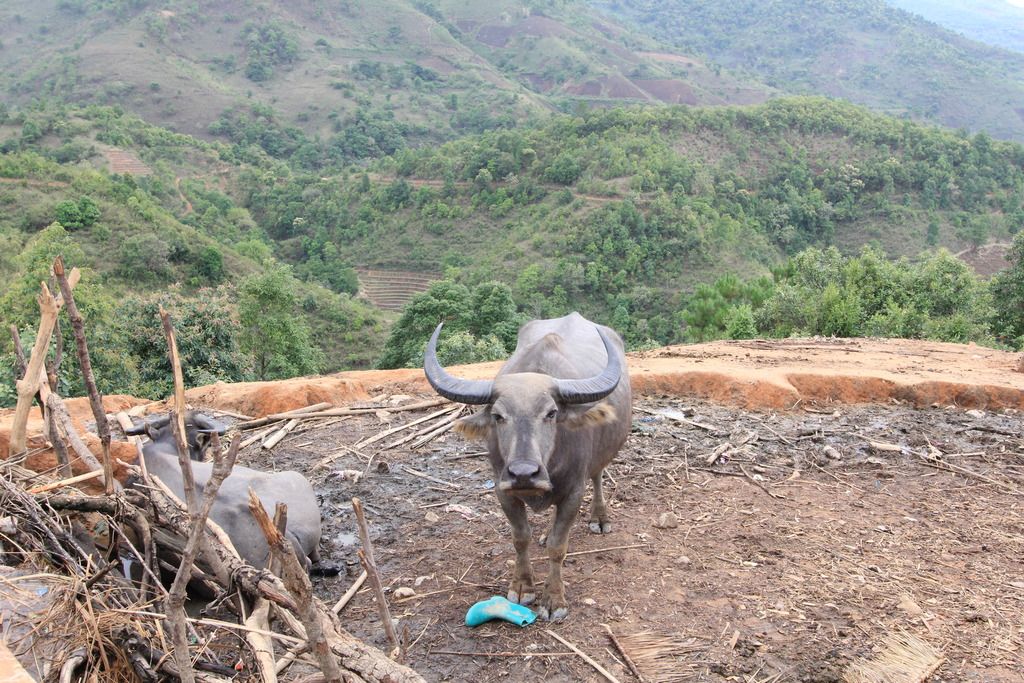 You lookin' at me?
You lookin' at me?
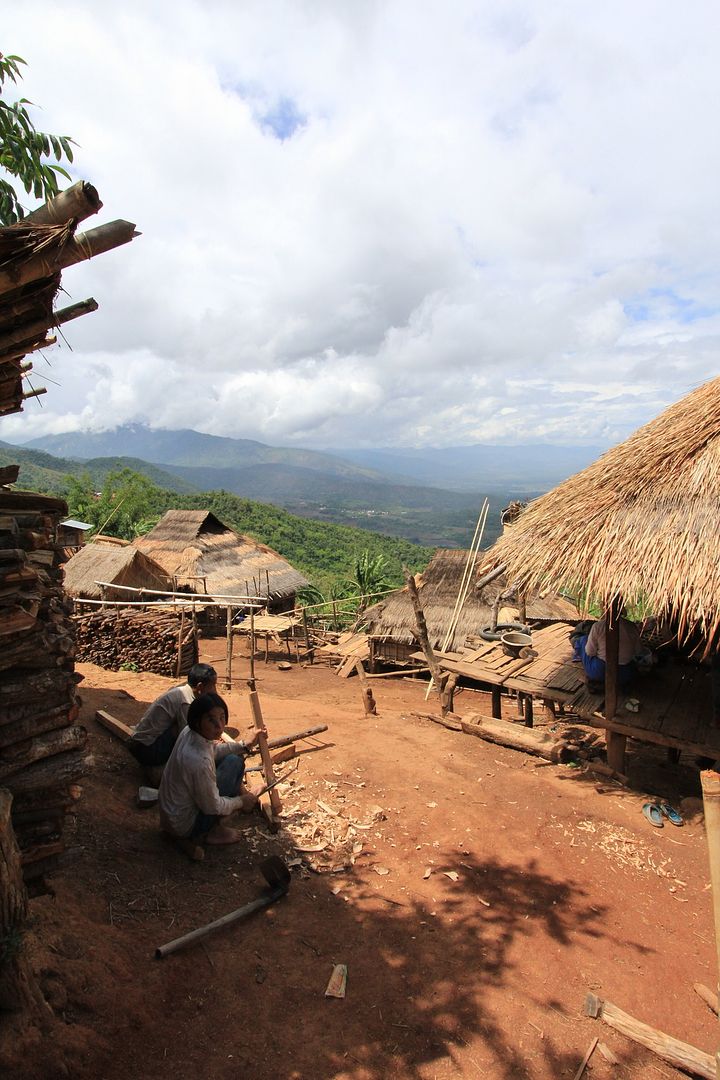
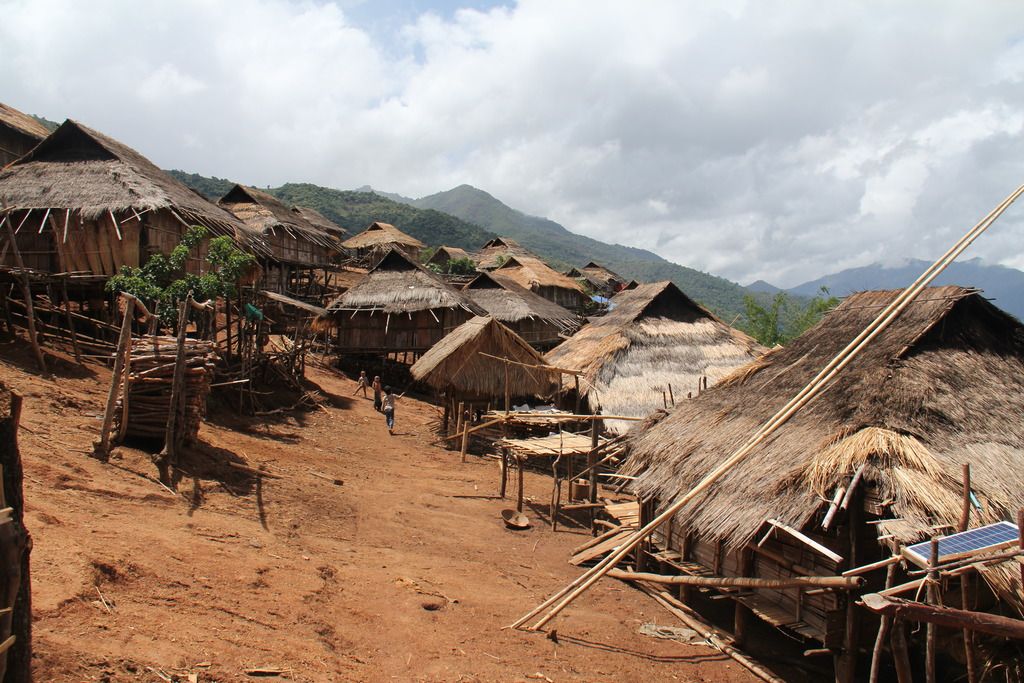 The village.
The village.
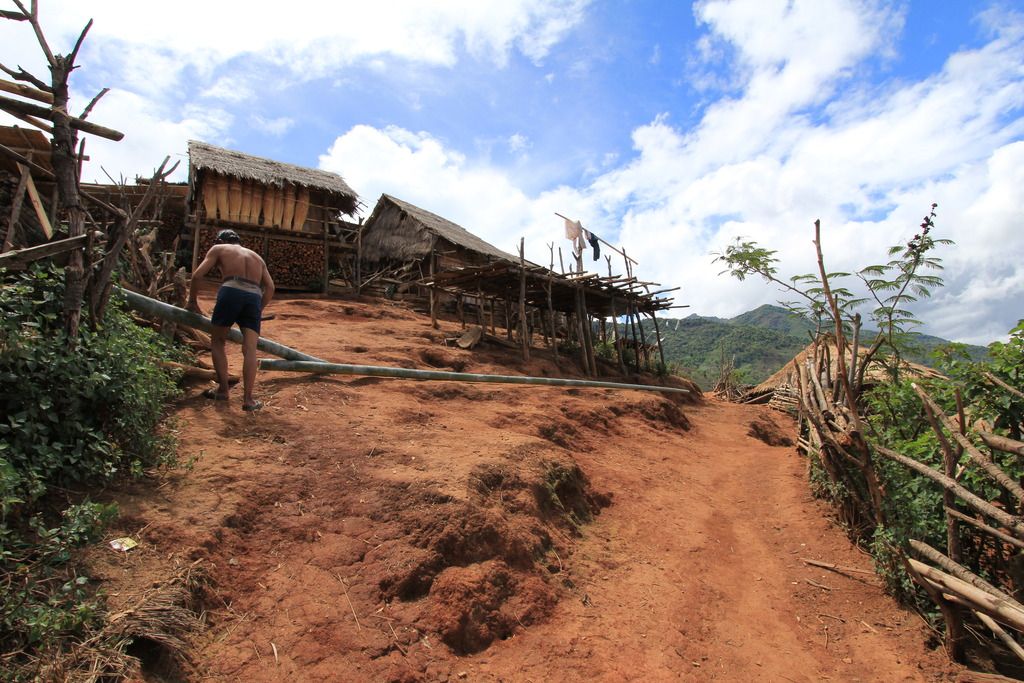
We walked around the area a little bit, then started to head back down towards the motorbikes. Enroute, we ate lunch, which we got at the market: sticky rice, some fruit, and a few other things. The sticky rice was really good.
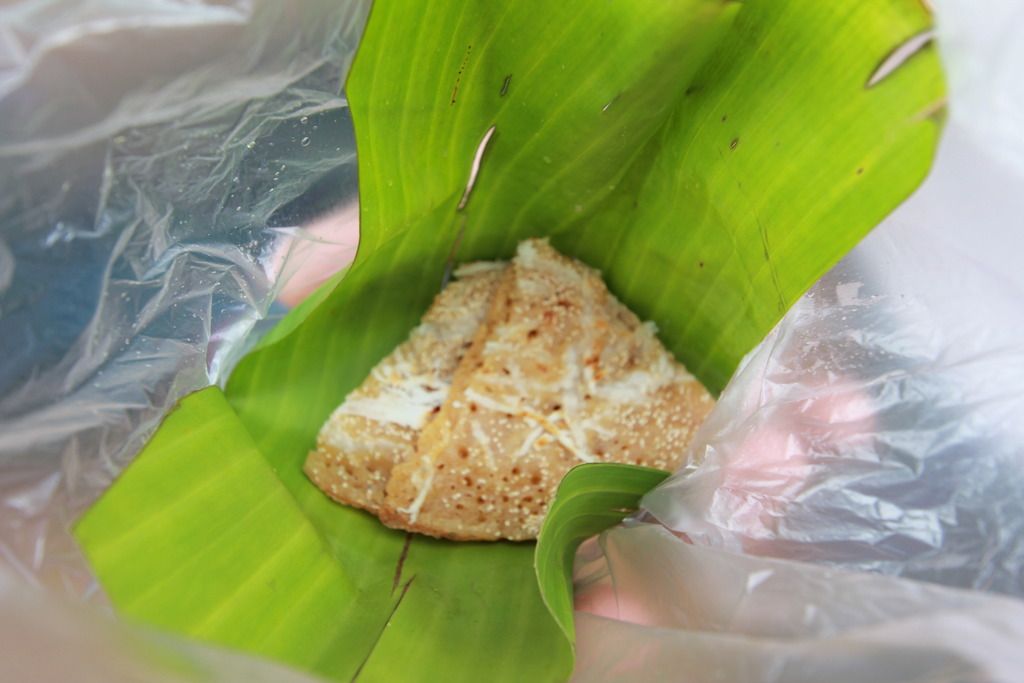
After reaching the motorbikes, we visited two other tribes, via motorbike, the Wa and the Palaung Tribe. Not many people interactions here, just checking out how they built homes and such differently. These people were down in the valley, so they had easier access to electricity and such, and probably jobs in Kengtung, I would imagine. It was interesting to see the differences in building techniques and such.
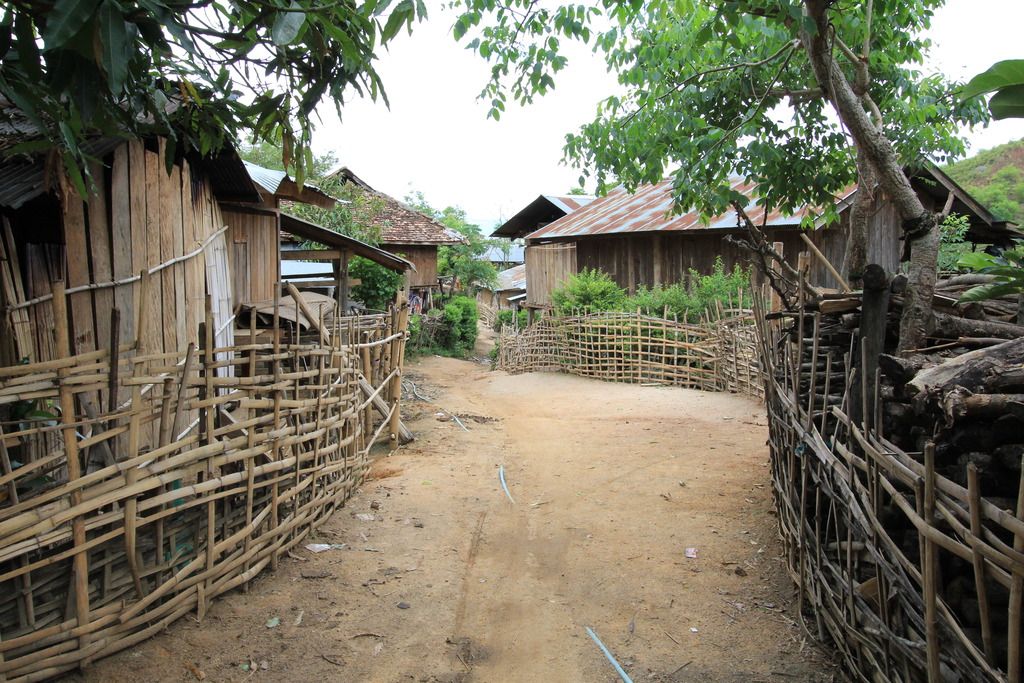 Walkin' back.
Walkin' back.
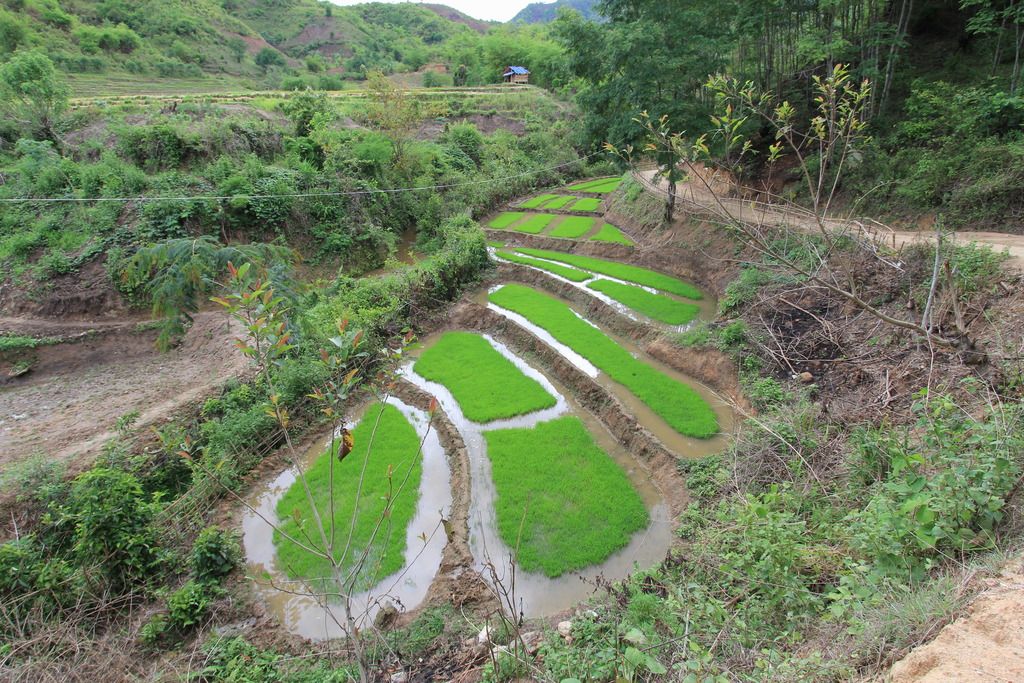
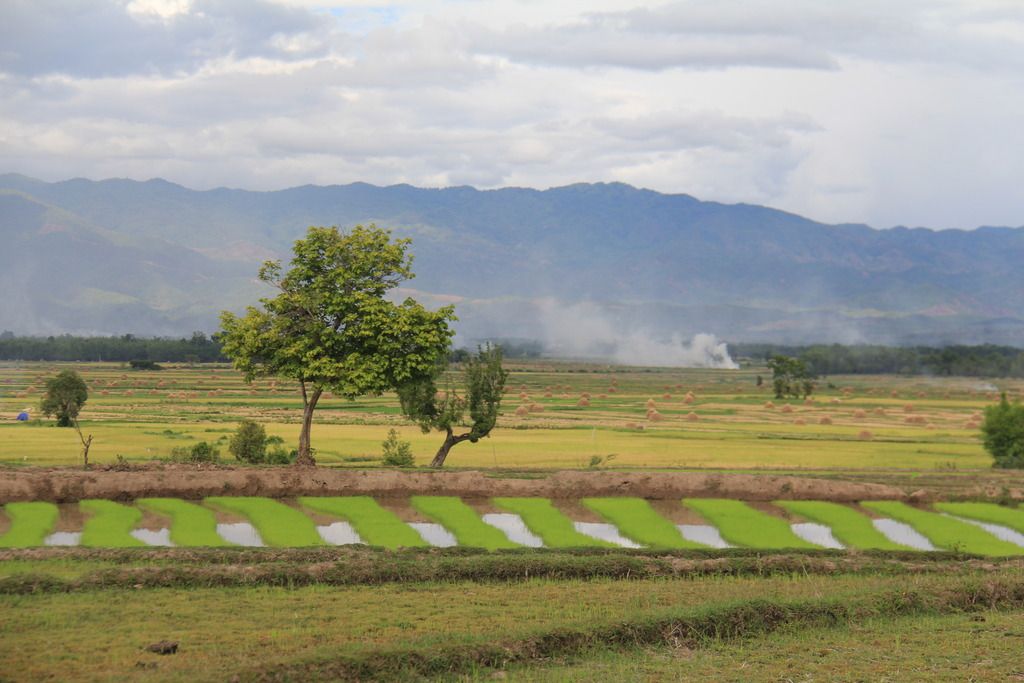
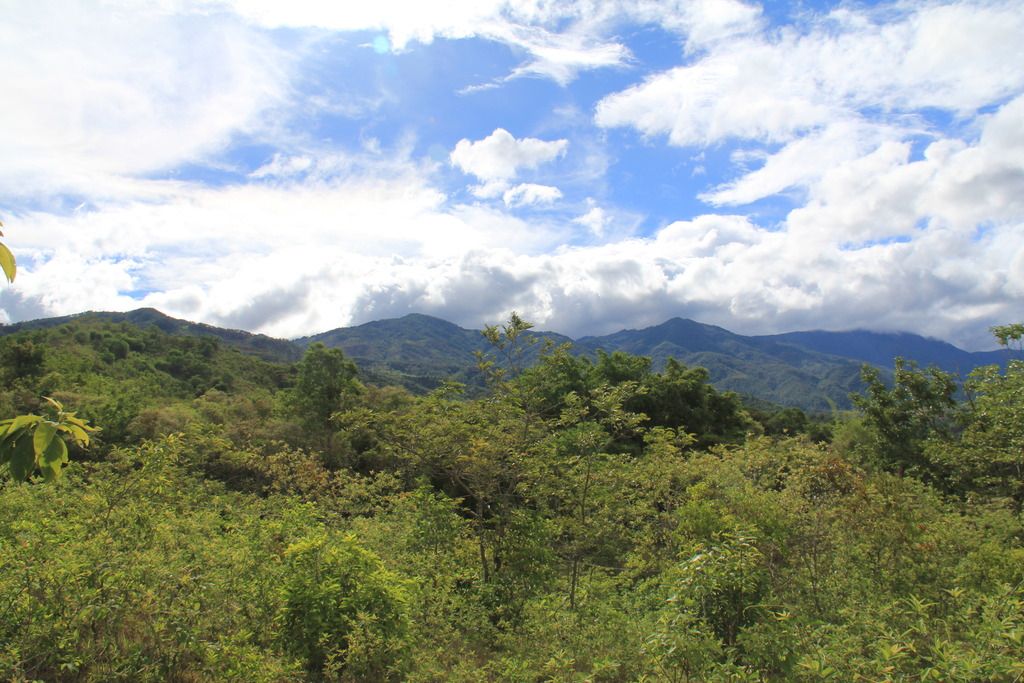
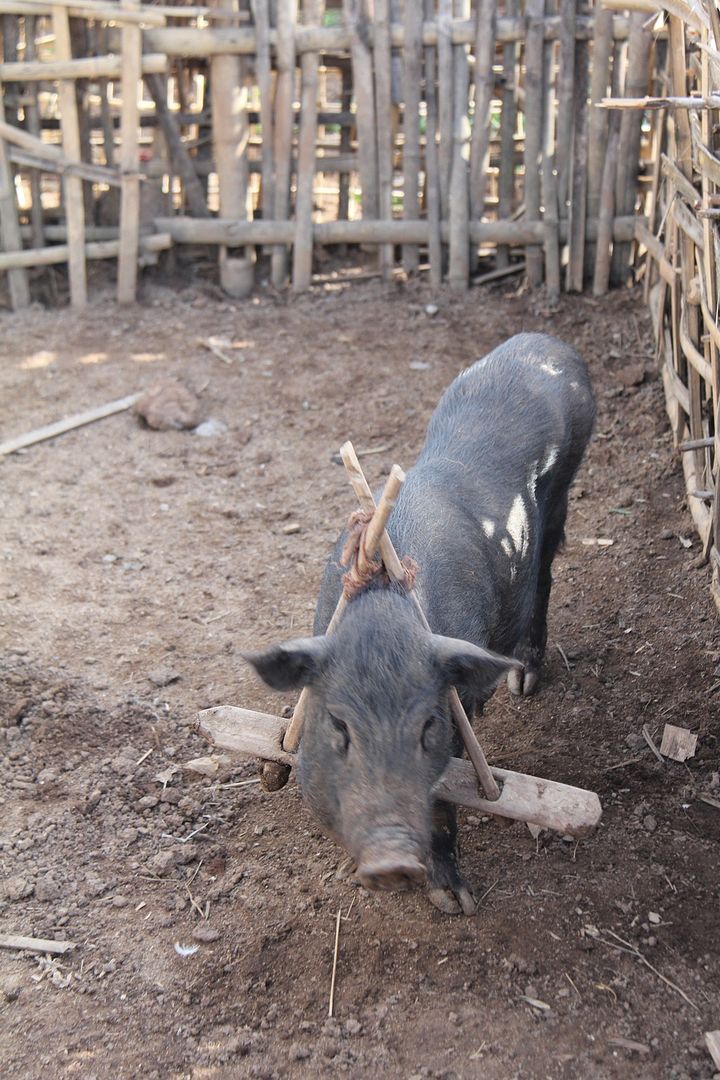 This pig was "naughty."
This pig was "naughty."
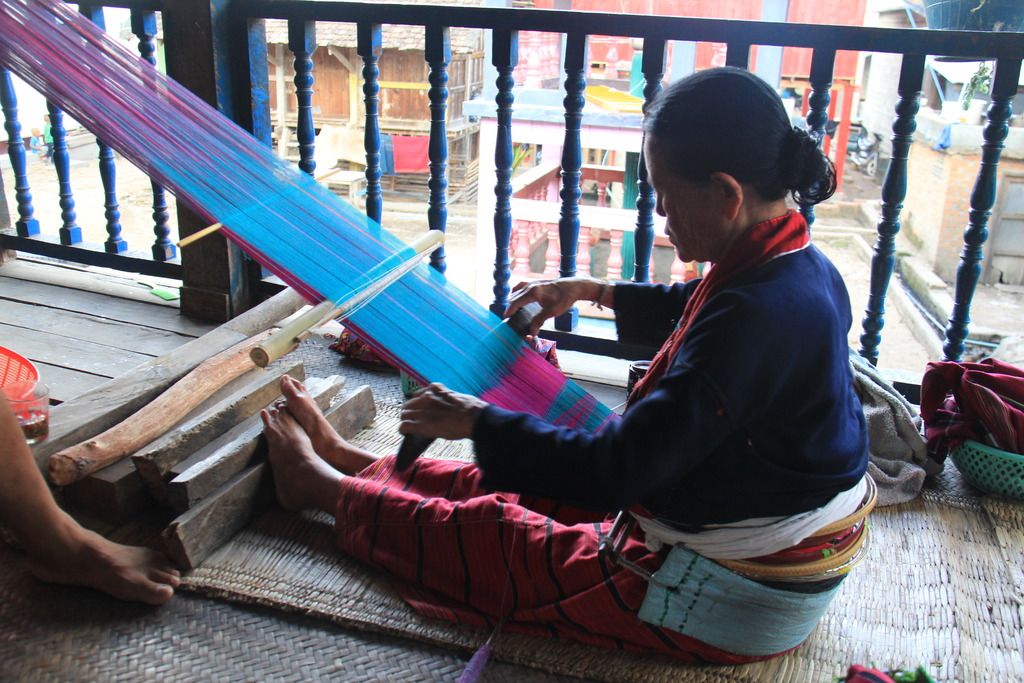
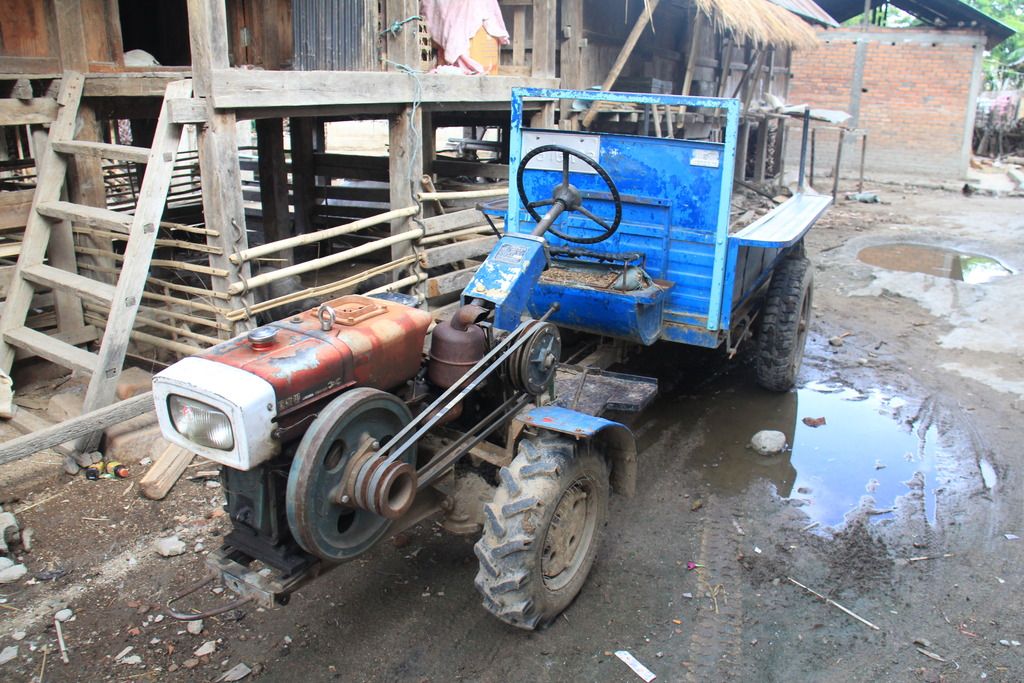 The workhorse of Myanmar.
The workhorse of Myanmar.
After the two tribes it was back to Kengtung, amongst some more beautiful rice fields. I was really grooving on the rice fields the whole time, every day, since it is something I have never really seen before. The people working in the field show what Myanmar really is: a lot of manual labor with a few Chinese engines thrown in. I could not believe how much manual labor I have seen, things that we would make a machine for they are doing by hand. Kind of cool. For dinner, we went to Never Forget, another good, but not great dinner with a nice view over the lake in Kengtung. The view was quite nice. Not much goes on in Kengtung after about 7 PM, so we went back to the hotel, and hung out, a common occurance these days.
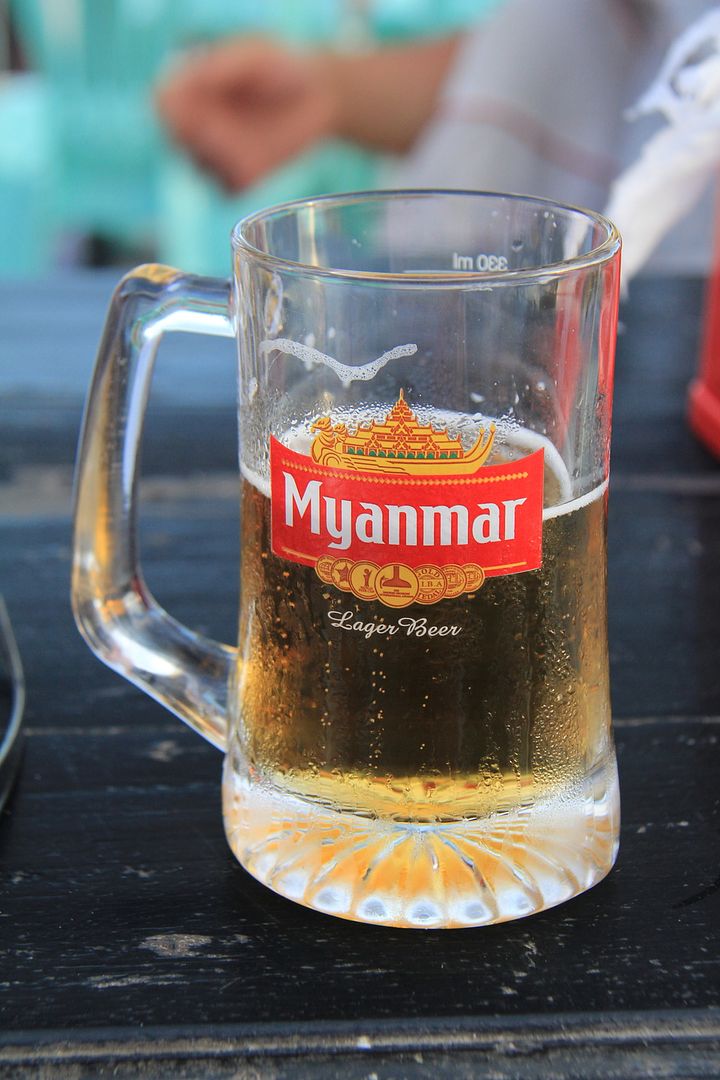
The next day, dad was not feeling too well, so we took it easy and did a little less hiking. The day started again in the market, getting materials for lunch, followed by an hour motorbike ride to a place that they made an alcoholic rice beverage. It was not Sake, or even close to it, but was more like rice whiskey. Nonetheless the stuff was strong, and they did not know how much alcohol was in it, but it tasted strong to my college tastebuds, something on the order of Everclear, but maybe not that strong.
 Why yes, I would love to try some of your FDA approved beverage served in what appears to be a jerry can designed to be used for the transport of petrol.
Why yes, I would love to try some of your FDA approved beverage served in what appears to be a jerry can designed to be used for the transport of petrol.
The process was pretty simple: Steam some rice with some of its kernel (the rice was shelled), then lay it out on a mat and let it cool, adding yeast after it had cooled. From here, throw it into a bag with some water and let it ferment for ~28 days. After that time was up, they put the remnants into a still made from steel barrels, which drained into some water containers. This stuff was then cooled and bottled in old Coca Cola bottles and such, and sold for about 2,000 MMK each. What a deal! Apparently, according to Dominik, our other guide, the longer you let it sit, the better it gets. Aged rice whiskey in plastic Coca Cola bottles, gotta love it.
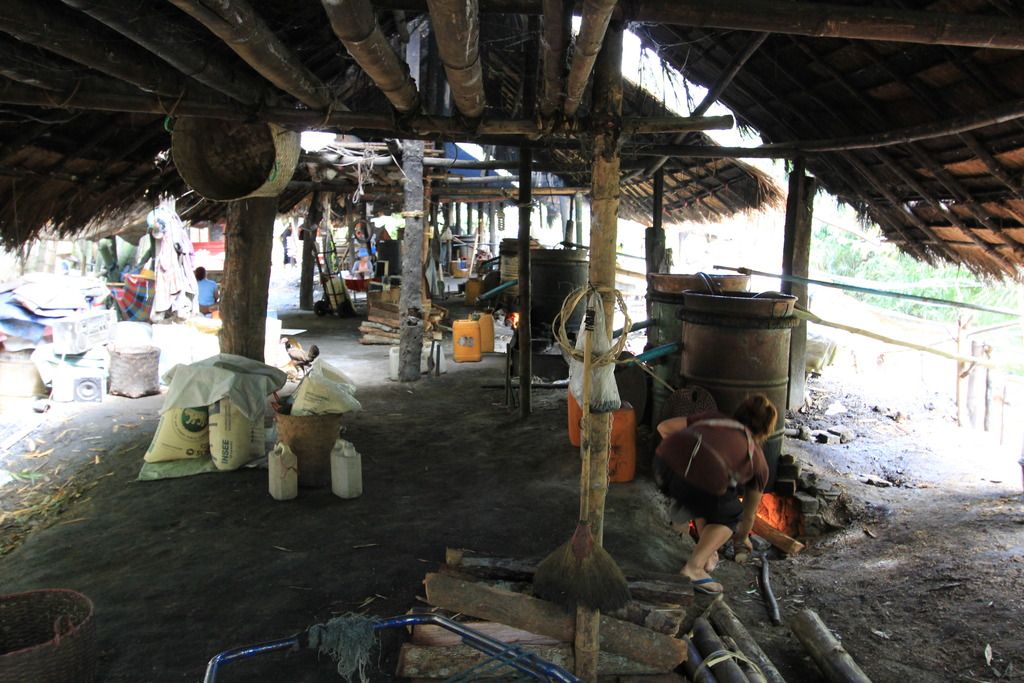

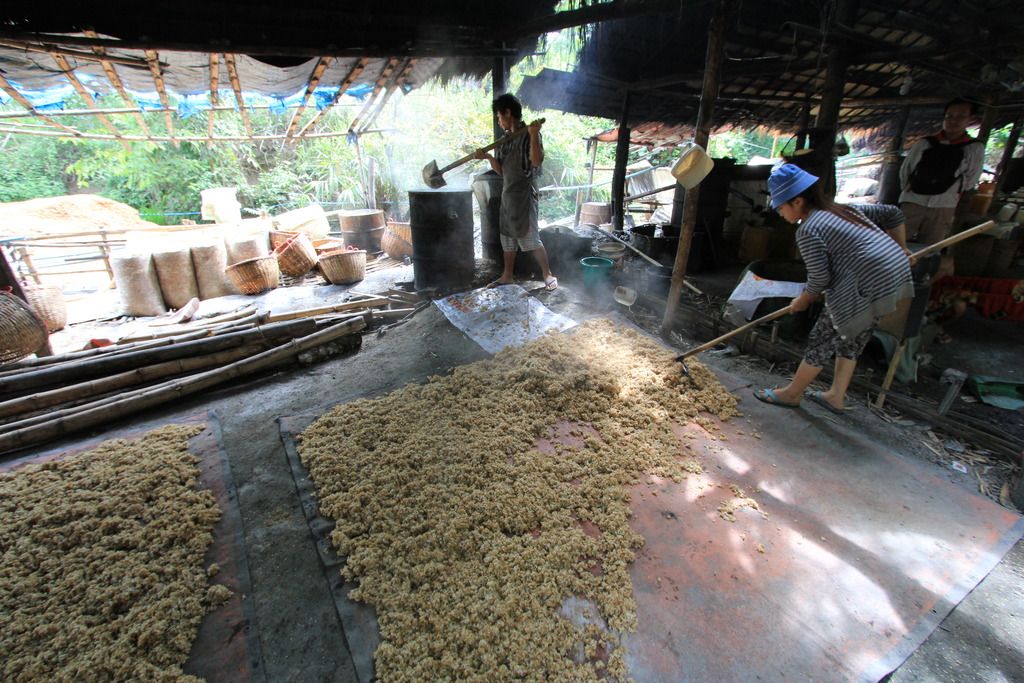 The spreading of the steamed rice.
The spreading of the steamed rice.
 Bags fermenting.
Bags fermenting.
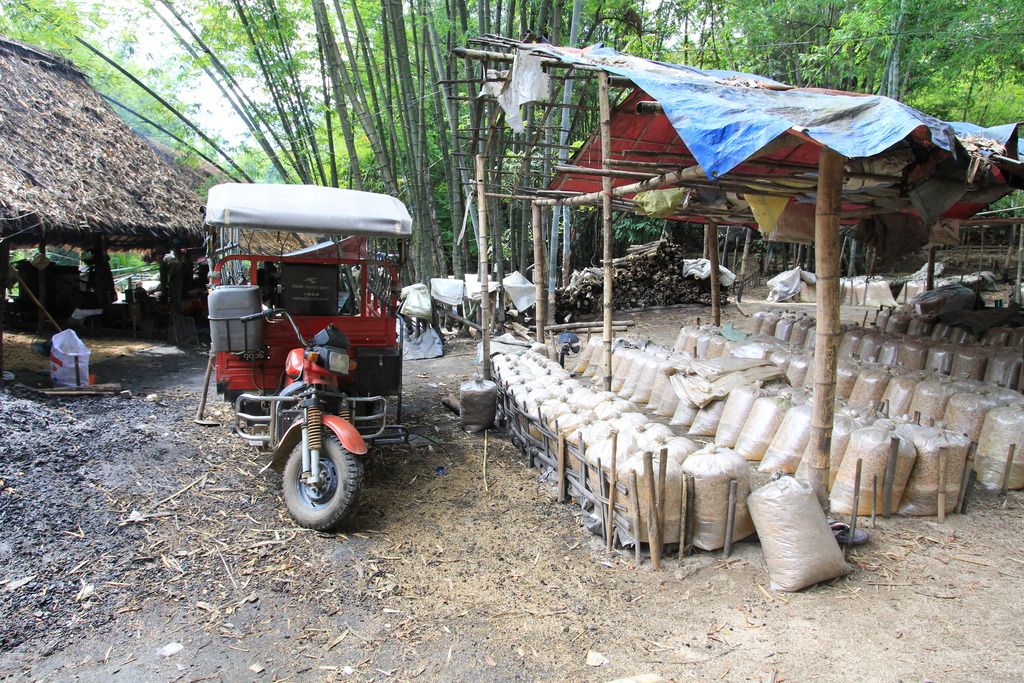
After a good half hour here, and a tad of sampling straight out of the distillation bucket, it was on to the trekking. About an hour and half up from where we left the motorbikes was the Pan Lea Village of the Eng Tribe, the people with the black teeth. The experience was again, slightly generic, but very nice. Every tribe we visited today gave us tea and peanut, roasted in an assortment of different ways.
 Rubber trees enroute.
Rubber trees enroute.
The Eng people were pretty cool, a bit more modernized with some huge houses, and some cool cooking environments inside each of the houses. Each house had a large deck, with a great view. The homes were one large room with a kitchen usually located at the back, and dorm like bedrooms which were separated from the main room with a sheet.
On the way out of town, dad decided to head back because his stomach was not feeling well, and I went onwards with Francis through some very nice rice paddies to the Akha Tribe. We ate lunch under the portico of the church at the top of the village (they were Christian). The views were magnificent, but unfortunately my DSLR battery died so only a few pictures from other devices of this village. I will amend the post when I am on a device that can transport pictures and such (formatting on the Chromebook does not jive too well).
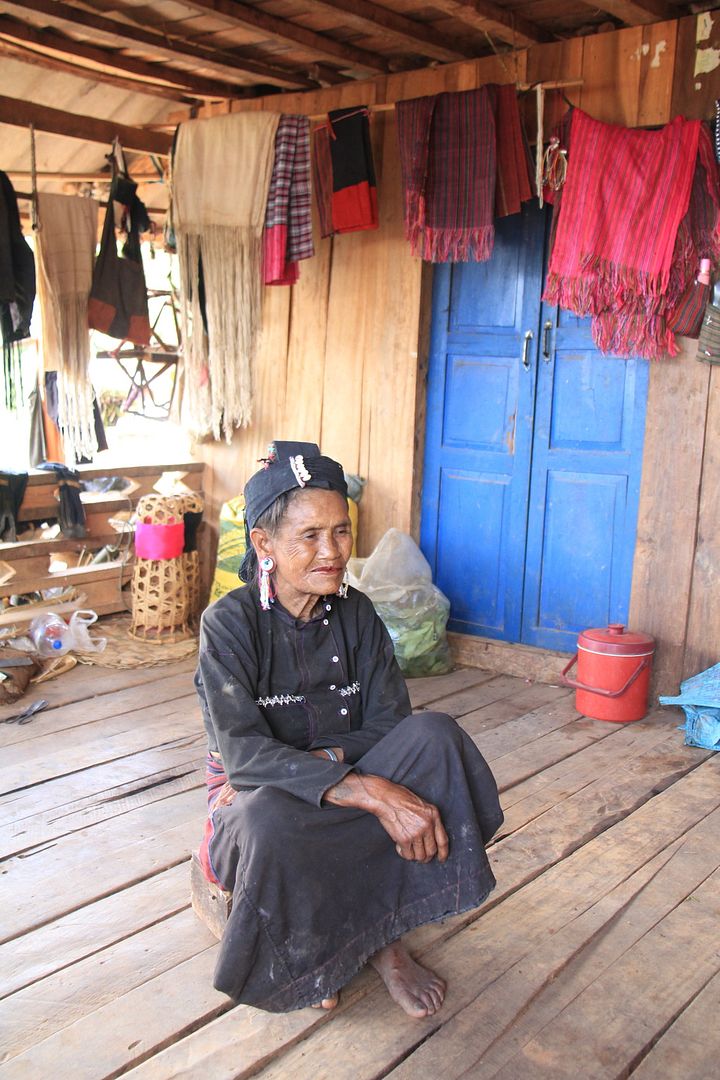 Possibly the most photographed woman in Kengtung...as I saw after perusing the web for a bit.
Possibly the most photographed woman in Kengtung...as I saw after perusing the web for a bit.
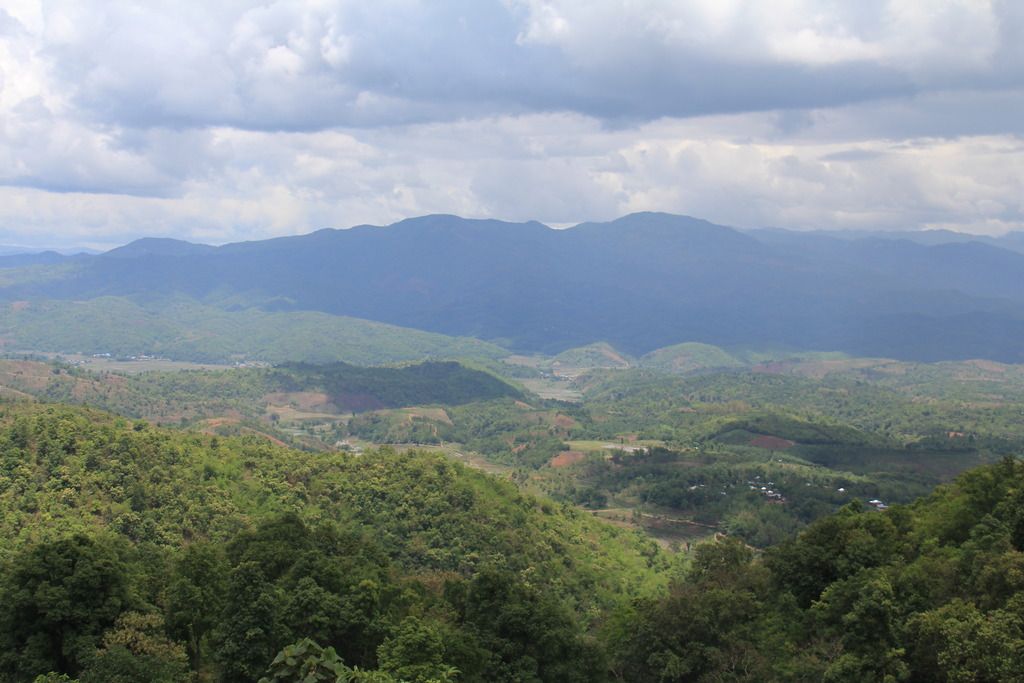 Above the Akha.
Above the Akha.
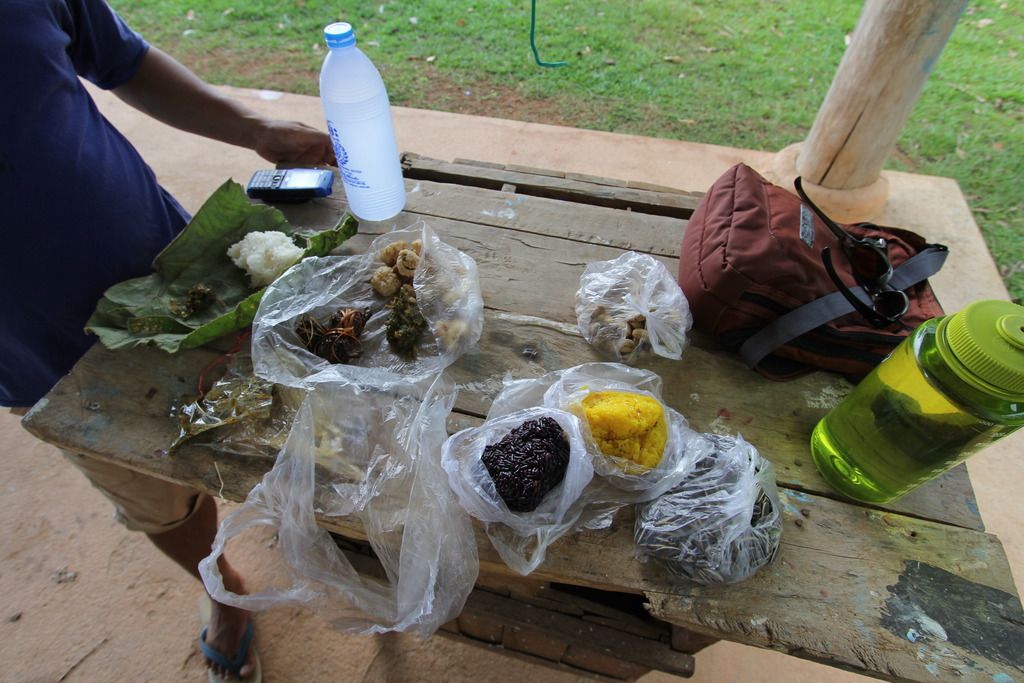 Lunch, with more sticky rice once again.
Lunch, with more sticky rice once again.
The Akha were again a bit more modernized, but were in native dressage a bit more. The woman with a large plate behind their heads were married, and the ones that were not married did not have the plate. The dressage had a lot of old Indian Rupees on them.
Inside one of the huts was a wild cat that was killed. They skinned it, then kept the pelt and stuffed it with rice. Apparently the cat was eating all of the chickens, so they killed it. It looked pretty cool, and would be a really cool thing to see in the wild. After the rain storm let up, it was onwards down the mountain and back to the hotel via motorbike. Upon entering Kengtung, we were stopped to look for narcotics. The police did not search me, only the locals, and Francis.
Dinner was at Golden Banyan Restaurant, which wasnít really good. Kengtung is hard to find good eats, except in the back of the market where noodle bowls abound, that is a must.
We were originally supposed to do 3 days of trekking, but dad was still not feeling too well, and it made little economic sense to pay for the guide for the day, so we were content on just walking around. I woke up early, and spent a good three hours in the market, cruising around and seeing some new stuff. This is without doubt one of the most authentic markets that I have ever seen. The market itself had zero tourists in it, and had no shops dedicated to it. You had everything from turmeric, to the butchers building to steamed peanuts to knockoff Levi jeans and aluminum pots large enough that you could cook a pubescent teenager in, and hopefully not get dementia (isnít that why we donít cook in aluminum anymore?).
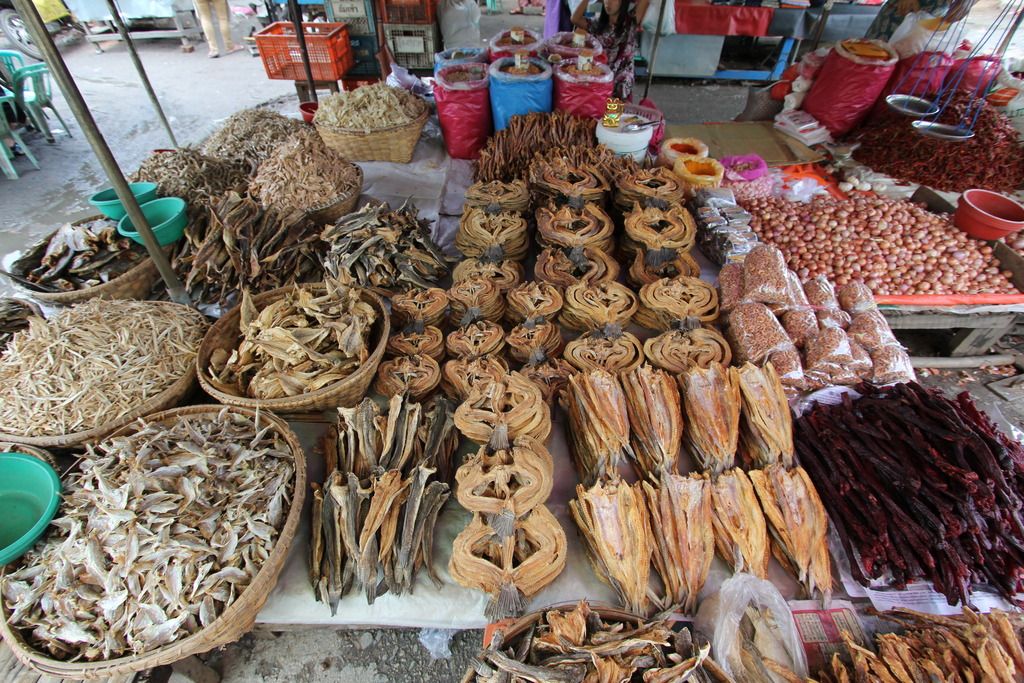
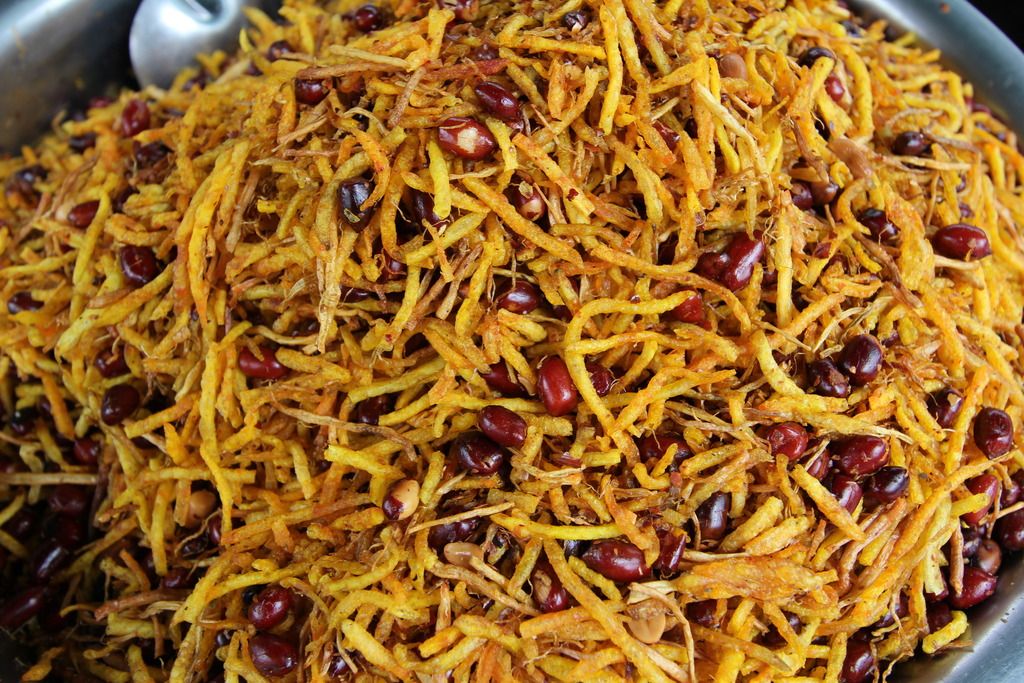
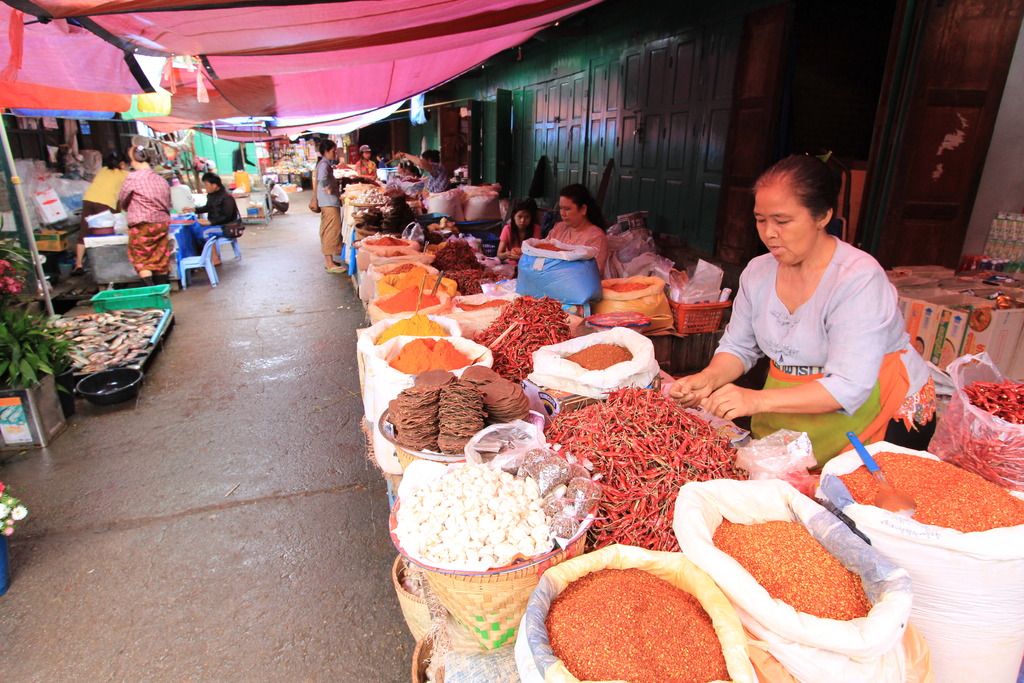
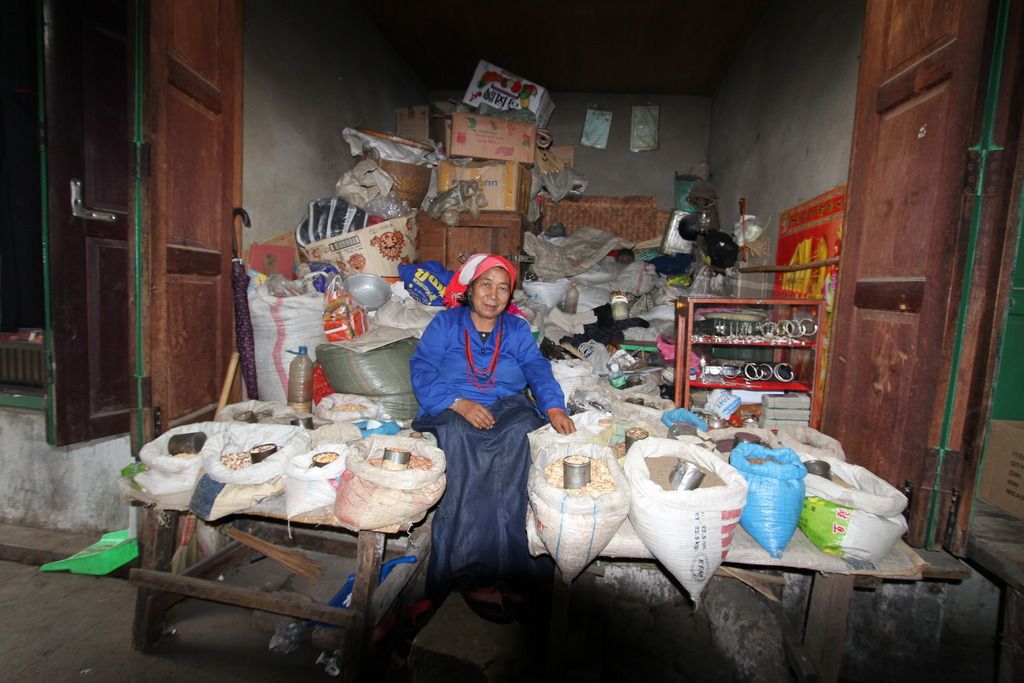
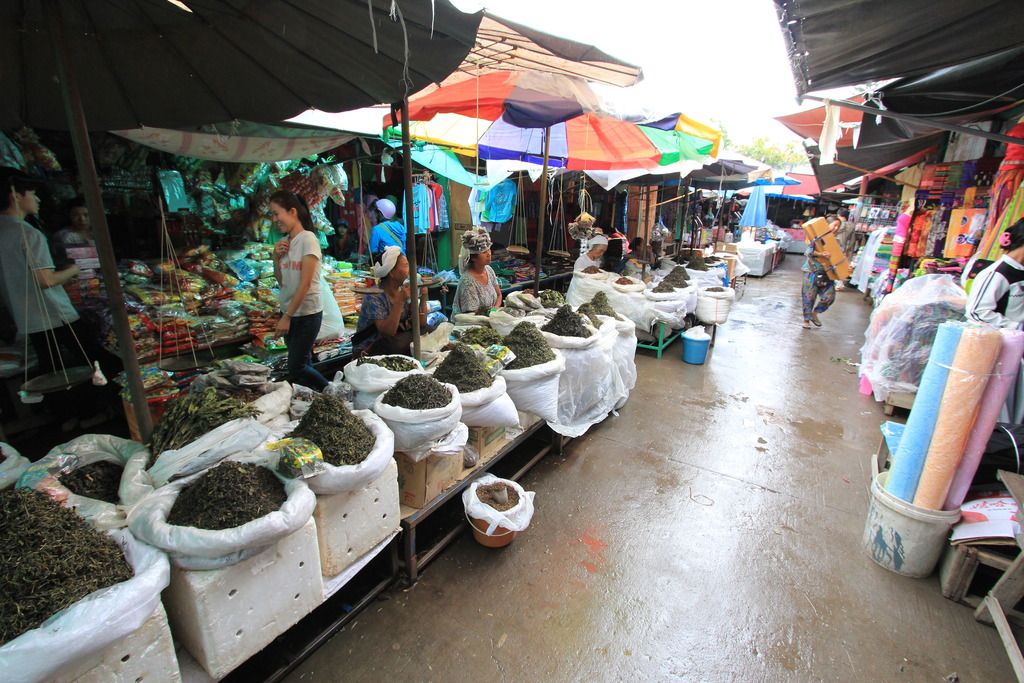
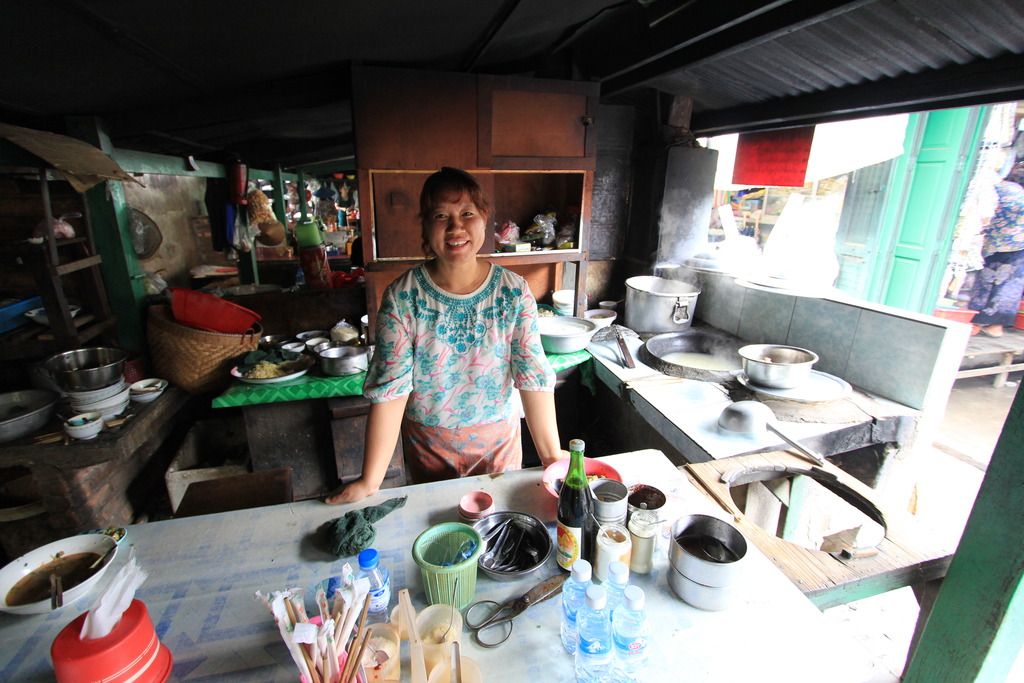
Everywhere you went, someone was willing to give you a sample of the weird, unappetizing thing that you were looking at, which most of the time turned out to be pretty damn good.
After the market, we walked around town to get a bit more of a feel for the place. It is loaded with old Hino trucks, belounis Chinese contraptions that somehow have torque ratios able to haul 40 bags of rice and the Chinese version of the workhorse tuktuk. The people, all smiled, and asked you some questions in broken English. They were curious, as were we, which made for some great interactions. To some, the streets of Kengtung may look like a giant shithole with all of the trash and rundown buildings, but once you step back, and look around, you can see that there is a charm about it that is unspoilt, not something you find in many other places these days.
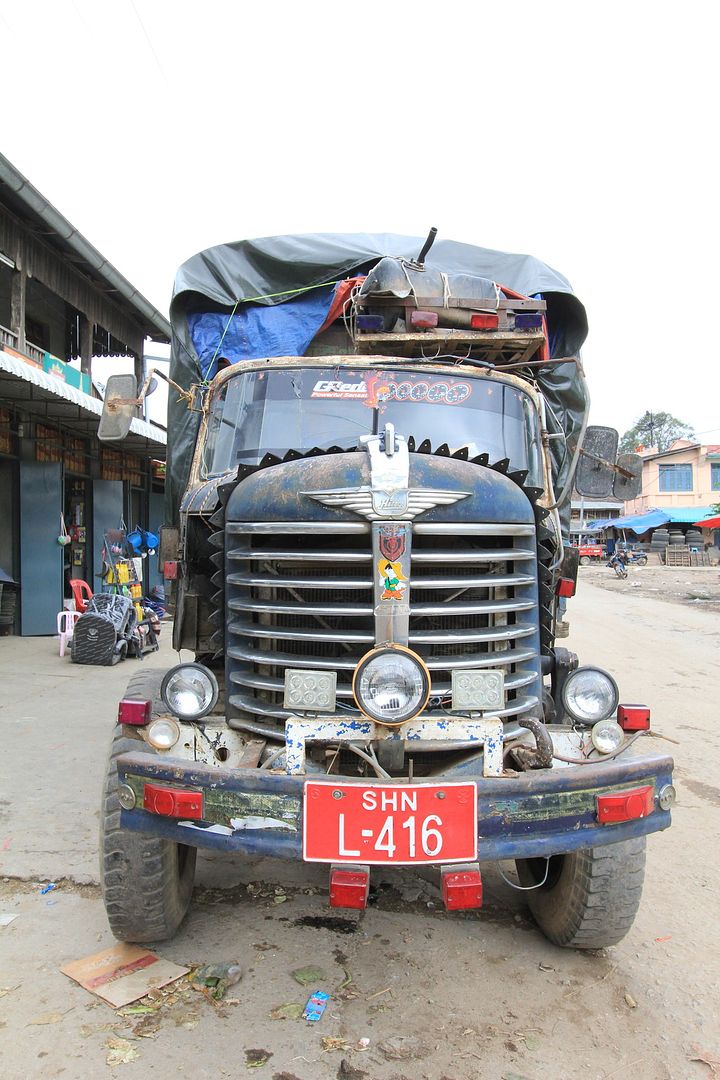
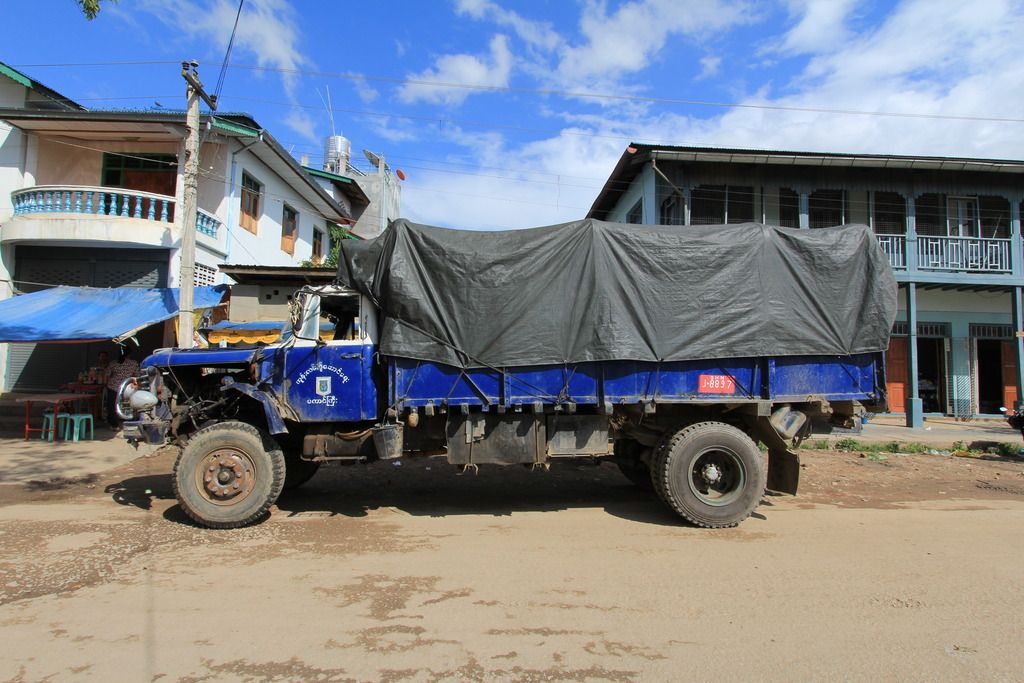
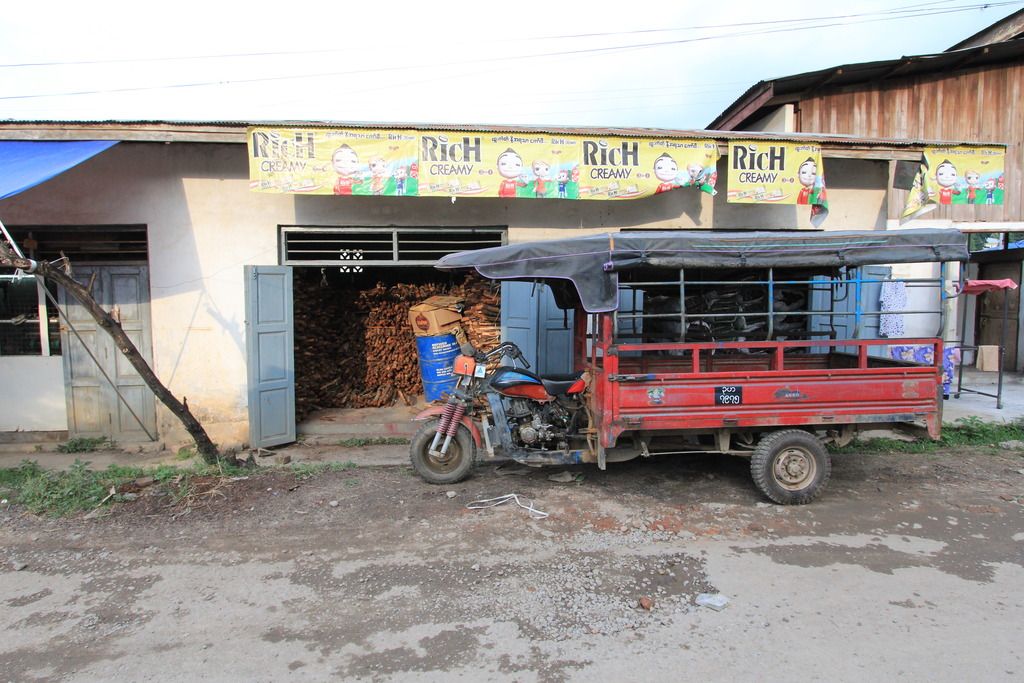
For dinner, we went to Azure, which was by far our best dinner in Kengtung. A simple Shan style noodle and Myanmar Beer on tap. All in, our dinner came to $4, not a bad way to go.

The following morning, we did more walking around, coming across a lacquerware shop, which was interesting.
When we finally needed to go to the airport, Francis showed up and gave us a tide in the Chinese version of a tuktuk. One of the more interesting drives to the airport that I have ever had.
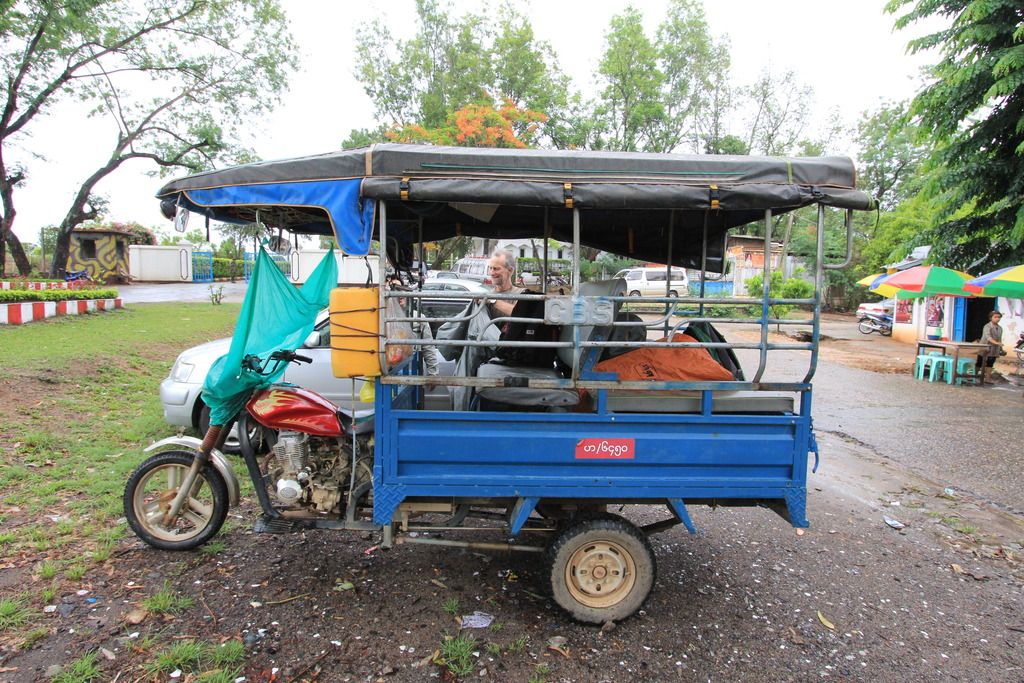
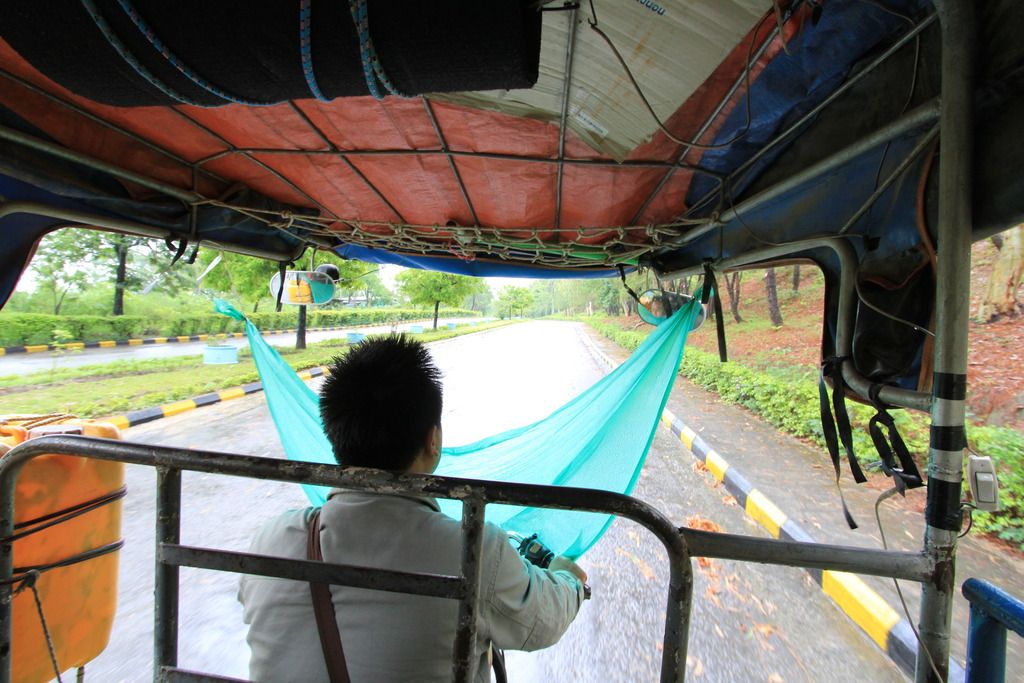 Nice wind screen
Nice wind screen 
Overall, I enjoyed Kengtung, a lot. The hill tribe trekking was okay, but not out of this world, and two days was good enough for me. It reconfirmed the fact that I am happy I did not do it in Thailand, though. Francis was a good guide, but nothing above and beyond, either. He seemed to not give you the full story sometimes. For instance, my dad asked (when about 10 dogs were around us), ďthey eat the dogs, donít they?Ē Francis said no, but then the next day he hinted that they did.
What I did enjoy was walking around the city by ourselves. People were very genuine, and the fact that we did not see another tourist was great, and made the town seem that much more authentic. Walking around after sunset was fun too, and we saw things that we would never expect, like a place where people were playing pool on some 5 pool tables, drinking beer and smokiní cigarettes.
I enjoyed walking down the street and people saying ďHello! My Friend!Ē and waving, since they tapped out their English language skills. Another treat was the market. Some markets these days are tainted by tourism, where people try to sell .... crafts and souvenirs that you will never use nor really want. There was not a single one of those things in the market here, and it was a true market, having everything from jeans to soup bowls to fish that were still alive. Yes, it was not the cleanest city in the world, and the garbage was a bit much at times (news to those of you that have not been to Myanmar, they donít believe in trash cans), but it was authentic. For that I really did like it. There are so many things that I could add, specifics of little unique things that I really enjoyed, but there are just too many of them to really describe. With that, maybe some of the pictures speak for it a bit more. Regardless, Kengtung was a nice way to enter Myanmar, since it was different from the rest of Myanmar, and letís be honest, land borders are always fun, so that was a nice touch too. I would like to enter China from here some day, but that border is not open. Regardless, I do see myself coming back, even though I donít really see my dad doing the same.
Next Up: Inle Lake and Bagan
